Quote Explanation Generator + Guide & Tips
- 👁️🗨️ Intro to Generator
- 👨🏫 Benefits of Quotations
- ✨ How to Perform a Quote Analysis

🔎 Quotation Types & Examples
- 🏆 Examples of Quote Analysis
🔗 References
👁️🗨️ intro to our quote explanation generator.
A quotation is a direct repetition of someone else's words, enclosed within quotation marks, and attributed to the original author. You can use it to provide evidence, support arguments , or add authority to writing or speech.
Quote analysis involves examining a quotation's context , intended meaning , and implications . You should go beyond surface-level understanding, exploring the underlying ideas, emotions, and significance conveyed by the selected words.
Quotations hold the power to inspire, inform, and challenge us. Thus, we created a quote explanation generator – the ultimate tool for unraveling the depths of any saying! Whether you picked a random quote that sparked your curiosity or you have an analysis assignment, it’ll provide insightful explanations for each phrase.
3 Key Reasons to Try Our Quotation Explanation Generator
Sometimes, quotes have double meanings or a thick layer of context that’s difficult to get through. Our quote explanation generator lets you get to the heart of the matter without spending hours on this process. Several factors make our app a valuable tool in your academic pursuits:
👨🏫 7 Benefits of Quotations in Your Writing
To master the art of writing papers, you need a lot of practice. Producing volumes of bland text isn’t enough. Your work should be interesting to follow, and quotes are one of the best tools to improve the quality of your written assignments.
- Better persuasion . Any piece should ultimately get the reader to accept your argument. You can achieve this goal by adding the most impactful quotes in the body of the text.
- Connect text and sources . Sometimes your writing doesn’t connect data from cited sources to the ideas discussed in its paragraphs. A good quote or two can bridge this gap.
- Enhance your writing . Quotes can make your writing more subtle and creative. This way, the text becomes more interesting and less monotonous.
- Larger context . Adding quotes lets you better evaluate and discuss the topic . They expand on the context and give essential details to your piece.
- More credibility . Having quotes in your paper makes it more credible. It helps readers see that your arguments aren’t based merely on your opinions.
- A touch of sophistication . Quotes are a great way to make your paper more sophisticated. It will lead to higher grades from your professors.
- Stronger arguments . Adding quotations lets you better introduce arguments and analyze ideas.
✨ How to Perform a Good Quote Analysis
Finding the core meaning of sayings can enrich your written assignment. In this segment, we’ve prepared a step-by-step guide to analyze quotes and uncover their potential. These guidelines will help you evaluate any quotes you can come across.
- Step 1 . Select a suitable quotation. Add the ones relevant to your paper’s subject. It should relate to either a person or an argument. Better use short citations to save time on analysis.
- Step 2 . Identify literary devices. Take a look at the choice of words in the quote. Pay attention to personifications, similes, metaphors, rhythm, alterations, and other devices . It helps better understand what the author tried to say.
- Step 3 . Establish the effect of the quote. Assess how the literary devices and additional techniques affect the quote. Experiment with different interpretations and consider which one is the most convincing.
- Step 4 . Find out the author’s intent behind the quote. Additionally, consider why the author chose to phrase their words in a certain way. For example, state if the quote has multiple meanings to keep it ambiguous deliberately.
During your detailed research , you might come across different kinds of quotes. There are three common ways of formatting a quotation in a piece of writing. We’ve decided to make a short guide that helps differentiate between them:
Integrating Quotations into Sentences
Knowing how to correctly incorporate quotes into your text is an essential skill that helps improve the value of your work. This section contains practical tips that make this process easier and enables you to create more credible writing.
- Introduce the quote with a colon and a complete sentence. It’s the most common use of a quotation that involves marks at the start and end of a quote. For example, in the words of Shakespeare: “ We know what we are, but know not what we may be .”
- Provide an explanatory or introductory phrase separate from the quotation with a comma. Here, you give a bit of context to explain a quote better. In The Picture of Dorian Gray, Oscar Wilde writes, “ Nowadays people know the price of everything and the value of nothing .”
- Make the quote a part of your sentence without additional punctuation . In this instance, the quotation becomes a part of your writing. For example, Dostoevsky argues that “ conscience without God is a horror. It can get lost to the most immoral .”
- Use several words from the quote in your sentence. It works the same as the previous example, although with smaller bits of the quotation. Duma’s advice to “ wait and hope ” runs throughout The Count of Monte Cristo .
🏆 Great Example of Quote Analysis
Here we've prepared an analysis of Les Brown's inspirational quote, “Shoot for the moon. Even if you miss, you will land among the stars.” This sample can inspire you to write your own essay on quote analysis; take advantage of our generator and tips!
We did our best to provide a comprehensive guide on quote analysis. After you check out our specialized tool, please take a look at our FAQ section. Lastly, if you need help analyzing other types of text, try our rhetorical analyzer .
❓ Explain the Quote Generator – FAQ
Updated: Oct 25th, 2023
- Suggested Ways to Introduce Quotations. – Columbia College
- Integrating a Quotation into an Essay. – Kelly Johnson, Ursinus College
- 5 Steps to Quote Analysis. – Luna Laliberte, Rutgers, The State University of New Jersey
- Quotation Analysis for Source Use. – Amanda Hardman, Red Rocks Community College, RRCC
- Working with Quotations. – Empire State University
- Quote Integration. – University of Nevada, Reno
- Free Essays
- Writing Tools
- Lit. Guides
- Donate a Paper
- Referencing Guides
- Free Textbooks
- Tongue Twisters
- Job Openings
- Expert Application
- Video Contest
- Writing Scholarship
- Discount Codes
- IvyPanda Shop
- Terms and Conditions
- Privacy Policy
- Cookies Policy
- Copyright Principles
- DMCA Request
- Service Notice
This page contains our free quote explainer generator. Discover the hidden meaning of famous sayings. This tool will also be helpful if you need to uncover literary devices. As a bonus, we have compiled a guide about quotations and their use in academic papers.

AI Essay Writer
Automated essay writing made easy.
- Academic essays: Generate well-structured essays on any academic topic, from literature to science.
- Research papers: Develop comprehensive research papers with well-referenced information.
- Opinion essays: Create persuasive opinion essays backed by solid research.
- Professional reports: Write detailed and informative reports on industry-specific topics.
- Personal essays: Craft engaging personal essays for college applications or personal blogs.
New & Trending Tools
In-cite ai reference generator, legal text refiner, job search ai assistant.
- Helldivers 2
- Dragon’s Dogma 2
- Genshin Impact
- Counter Strike 2
- Honkai Star Rail
- Lego Fortnite
- Stardew Valley
- NYT Strands
- NYT Connections
- Apple Watch
- Crunchyroll
- Prime Video
- Jujutsu Kaisen
- Demon Slayer
- Chainsaw Man
- Solo Leveling
- Beebom Gadgets
How to Use ChatGPT to Write Essays That Impress
Step 1: Use ChatGPT to Find and Refine Essay Topics
- Log into the service and type the following prompt into ChatGPT:
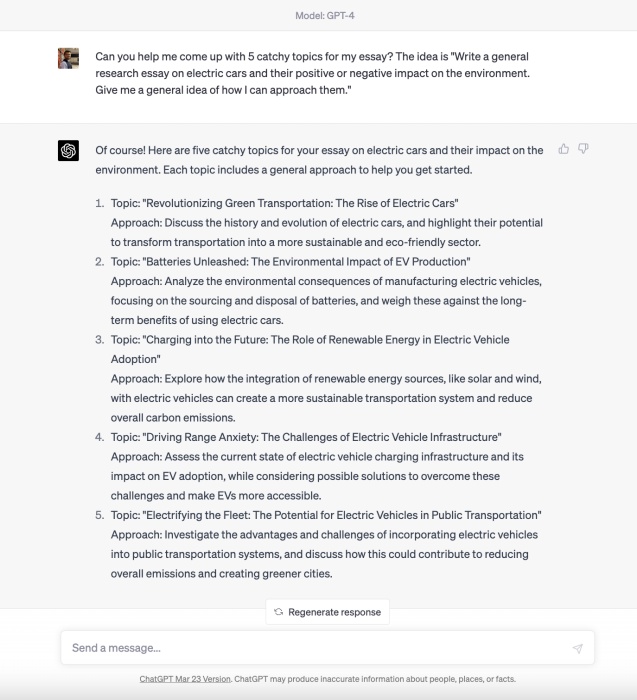
- As you can see, ChatGPT gave several good ideas for our essay. If you want to refine the idea further, you can ask the chatbot to cut out some parts of the idea and replace them. Or, you can ask for more context in certain parts. Example – “Expand more on topic number 5 and what it means.”
Step 2: Ask ChatGPT to Construct an Outline
- With the same chat open, type out “ Give me an essay outline for <selected topic>. Make sure to keep it structured as I’ll use it to write my essay .” In this case, I will use topic number 2 since it aligns with what I had in mind.

- As you can see above, we now have a structured outline for our essay. We can use this to write our essay or have ChatGPT do that job. Nonetheless, it’s a good starting point. As always, you can have the AI chatbot cut out parts of the outline or specifically add new ones depending on your requirement.
Step 3: Get ChatGPT to Cite Sources for Your Essay
Even though we have the idea and the outline, we will need to do our research for proof supporting our essay. Thankfully, ChatGPT can be of some help here. Since the chatbot is adept at moderate research, users can get a general idea of where to look for gathering information. Let’s begin doing that.
- Let’s begin asking ChatGPT for sources. With the same chat open, type in the following prompt:

- Now we have a list of 10 sources we can reference from. However, you can also see that ChatGPT mentions the year 2021 in some of them. Therefore, it’s best to use these websites but navigate to the latest pages pertaining to your essay for research. This applies to every topic, so always do it. Also, chatbots like ChatGPT have a habit of hallucinating and making up information, so do be careful.
Step 4: Have ChatGPT Write the Essay
- In the same chat, type the following prompt – “With the topic and outline available to you, generate a 700-word essay. Make sure to keep it structured and concise yet informational. Also, keep in mind my target audience is <Insert target audience> so cater to that accordingly.”
- In the middle of the essay, ChatGPT might stop and not answer. Simply type “ Continue ,” and it will finish the rest of the essay.
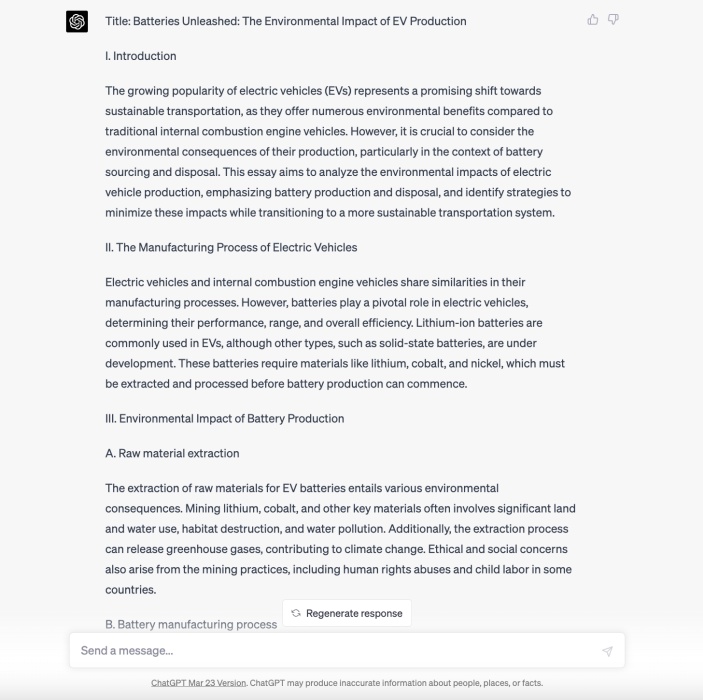
Step 5: Edit the Essay with ChatGPT
No matter if you have used ChatGPT to draft a complete essay or have written one yourself, you can use this step to make ChatGPT your co-editor and grammar checker. While your essay might need an initial look from a human, you can definitely use the bot to hash out the tone and add little details.
- Either open up the same chat or have your essay already in the clipboard. With that done, type out the following prompt:
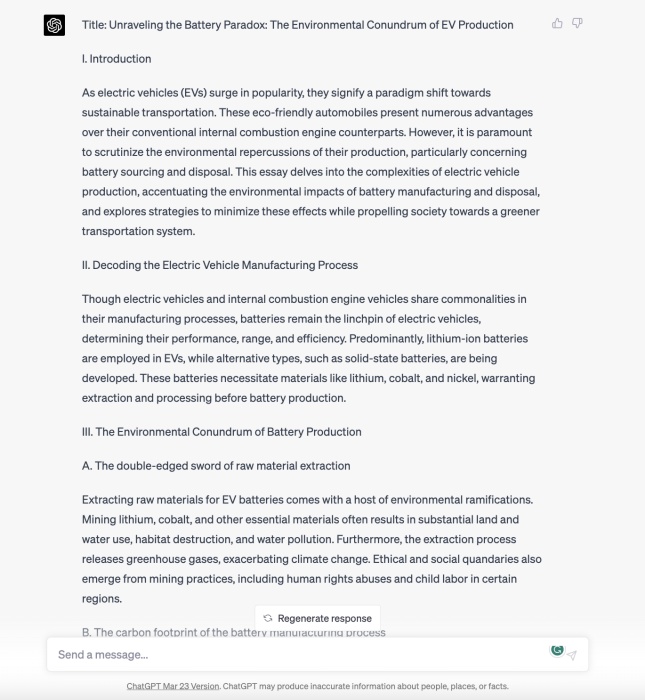
Step 6: Export the Essay for Submission
However, for those who want to export the essay into a more aesthetic format, we have just the thing for you. There is no shortage of best ChatGPT Chrome extensions on the internet right now. We have one such selection linked in our list that can export selective chats onto beautiful image formats if you want to show off your essay. Check it out and let us know how you liked it.
Bonus: ChatGPT and AI Apps to Write Essays
1. writesonic.
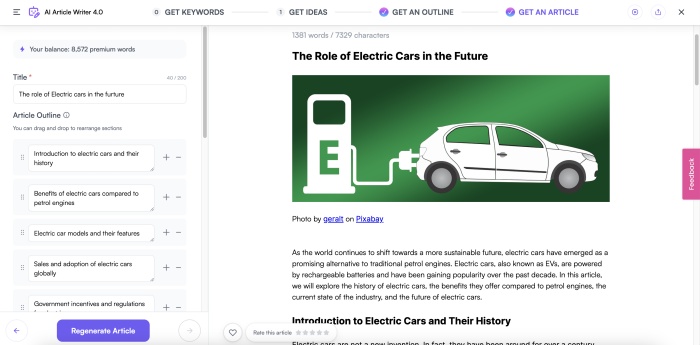
Ryter is another helpful AI writing assistant that not only helps with essays but all types of articles. The service is powered by a language model that gives it intelligence. Rytr comes with 40+ different use cases and 20+ writing tones for all types of written material. For those who don’t want to stick to English, it even comes with support for 30+ languages.

Upanishad Sharma
Combining his love for Literature and Tech, Upanishad dived into the world of technology journalism with fire. Now he writes about anything and everything while keeping a keen eye on his first love of gaming. Often found chronically walking around the office.
Im student i want to become financially independent woman in life so I want esay essay write
I am housewife and I want easy essay I want to change my life my husband was job less and I want to work online part time job plz help I am enter pass
Add new comment


ESSAYBOT | THE BEST AI TOOL EVER?

- Our Verdict
- Overview of Essaybot
- Pros and Cons of Essaybot
- How We Tested Essaybot
- Our Review Rating System
- Alternatives to Essaybot
- Essaybot FAQ

Our team evaluated Essaybot and discovered a diverse range of features, encompassing content generation and plagiarism checks. These innovative capabilities directly tackle common writing hurdles, offering valuable support in crafting well-structured essays. However, it's essential to acknowledge certain limitations, such as a basic grammar check and the necessity for user-initiated revisions.
In our exploration, we also delved into alternatives. Each of these options boasts unique strengths, providing compelling choices for writers. By comprehending the respective advantages and disadvantages of these tools, individuals can make informed decisions regarding the best fit for their specific writing needs. Ultimately, we emphasize the importance of using these tools as aids to enhance, rather than replace, one's own writing proficiency.

In today's fast-paced academic landscape, the demand for efficient and effective writing tools has never been higher. Our team evaluated Essaybot , an Artificial Intelligence (AI)-powered tool that you can use to write essays. This innovative tool offers a range of features aimed at streamlining the essay creation process, from generating original content to providing accurate citations.
In this detailed overview, we'll dissect Essaybot's capabilities and assess how it can be a game-changer for students and writers alike. Our AI experts tested this tool to provide you with a comprehensive understanding of its potential benefits.
AI Writing Assistant Extraordinaire
At the heart of Essaybot lies its powerful AI engine, a sophisticated system trained to understand and generate human-like text. This enables the tool to not only assist in constructing essays but also provide valuable content suggestions such as an essay title or topic. The AI's ability to mimic human writing styles and produce coherent, structured content sets Essaybot apart as a next-generation writing companion.
We put Essaybot's powerful AI engine to the test, providing it with prompts for various essay topics. The results were impressive - the generated text was coherent, structured, and closely resembled human writing styles. This demonstrated the tool's ability to assist in constructing essays effectively.
Sentence Rephraser
Essaybot takes sentence construction to the next level with its advanced sentence rephrasing feature. This function analyzes and suggests alternative phrasings for sentences, enhancing clarity and flow. By offering diverse ways to express ideas, Essaybot empowers writers to create compelling and well-articulated essays that leave a lasting impression.
We used this feature to analyze and rephrase sentences from sample essays. The suggested alternative phrasings significantly improved clarity and flow, showcasing the value of this function in enhancing the overall quality of writing.
Plagiarism Check
One of the standout features of Essaybot is its robust plagiarism checker. This tool goes beyond basic checks, ensuring that the content generated is entirely plagiarism-free. By erasing or rephrasing any potentially plagiarized sections to erase plagiarism concerns. Consequently, you can submit your work without the specter of academic misconduct looming over them. This capability is especially crucial in today's academic environment, where originality is paramount.
Our team provided both original and plagiarized content to see how effectively Essaybot's plagiarism checker identified and corrected the issues. The tool surpassed our expectations, ensuring the generated content was entirely plagiarism-free. It effectively erased or rephrased potentially plagiarized sections, providing confidence in the originality of the work.
Sentence Formatting
In addition to its prowess in content generation, Essaybot also excels in refining the presentation of your work. The tool offers valuable suggestions for sentence formatting, ensuring that your essay is not poorly structured. This attention to detail helps create a polished final product that stands out in terms of both substance and style.
We fed poorly structured sentences into Essaybot to observe how it would enhance their presentation. The tool's suggestions for sentence formatting were invaluable, leading to a more polished final product that stood out in terms of both substance and style.
Tone Checker
Understanding the importance of conveying the right tone, Essaybot comes equipped with a tone checker. This feature analyzes the text to determine its overall tone, allowing users to adjust their writing style accordingly. Whether it's a formal academic paper or a persuasive argumentative essay, Essaybot ensures that your writing strikes the right chord with your audience.
We experimented with different writing styles and tones, from formal to persuasive, to gauge the effectiveness of the tone checker. The feature accurately analyzed the text and provided valuable insights to help users tailor their writing style to their intended audience and purpose.
Grammar Check
Flawless grammar is non-negotiable in academic writing, and Essaybot rises to the occasion with its comprehensive grammar checker. While the tool's grammar check is commendable, it's worth noting that it provides a basic level of correction for poorly written sentences. For more intricate grammar corrections of your own essay, you may still need to exercise your own proofreading skills.
We tested the grammar checker with sentences containing various types of errors, from basic to more complex. While the tool performed well in correcting basic grammar mistakes, it's important to note that more intricate corrections may still require the writer's own proofreading skills.
Autocorrect
To put the finishing touches on your essay, Essaybot incorporates an autocorrect feature. This function helps catch any last-minute errors or typos, ensuring that your work is error-free and ready for submission. By providing this additional layer of scrutiny, Essaybot ensures that your essay meets the highest standards of quality.
To evaluate the autocorrect feature, we intentionally introduced errors and typos into sample essays. Essaybot efficiently caught and corrected these last-minute mistakes, ensuring the final product was error-free and ready for submission.
As with any AI tool, Essaybot comes with its own set of advantages and limitations. In this section, we'll provide a comprehensive overview of the pros and cons of this AI-powered essay writing assistant, enabling you to make an informed decision about its utility in your writing endeavors.
Content Generation Assistance: Essaybot's AI capabilities shine when it comes to content generation. It can provide valuable content suggestions based on essay titles or topics, making it a useful tool for overcoming writer's block or finding relevant information.
Plagiarism Check: One of Essaybot's standout features is its robust plagiarism checker. It goes the extra mile to ensure that the generated content is entirely plagiarism-free. This is invaluable for maintaining academic integrity and avoiding plagiarism concerns.
Sentence Rephrasing: Essaybot's sentence rephrasing feature offers a fresh perspective on sentence construction. By suggesting alternative phrasings, it helps improve the clarity and flow of your writing.
Autocorrect and Grammar Check: The tool includes an autocorrect feature and a basic grammar checker, which can help users polish their essays and eliminate common errors before submission.
Tone Checker: Essaybot's tone checker analyzes the text to determine its tone, allowing writers to adjust their writing style to suit the intended audience or purpose.
Citation Finder: Essaybot includes a smart citation finder that produces citations matching the source and text, saving users time and effort when citing.
Visual Presentation: Essaybot also offers suggestions for sentence formatting, ensuring that the final essay is not only well-written but visually appealing.
Free Access: Essaybot is available as a free tool, making it accessible to a wide range of users who may be working on essays or academic papers.
Limited Grammar Check: While Essaybot offers a basic grammar check, it may not cover more complex grammar issues. Users may need to rely on their own proofreading skills for more advanced grammatical corrections.
Content Suggestions from Google Searches: The content suggestions provided by Essaybot are sourced from top Google searches. While this can be helpful, it may not always guarantee the most comprehensive or authoritative sources for academic writing.
Paraphrasing Challenges: Essaybot's paraphrasing feature, while useful, may sometimes produce text that is overly convoluted or contains grammar and punctuation mistakes, making the text less readable.
Lack of Revisions: Essaybot does not offer revision services. Users are responsible for proofreading and editing their essays themselves, which may be a drawback for those seeking more comprehensive writing assistance.
1. Ease of Use : Our team assessed Essaybot's user interface and navigation to ensure it was intuitive and user-friendly. We considered how easily users could access and utilize its various features.
2. Speed of Content Generation : We measured the time it took for Essaybot to generate coherent and relevant content for given prompts. This criterion was crucial in evaluating its efficiency for time-sensitive tasks.
3. Accuracy of Plagiarism Checks : We provided both original and plagiarized content to gauge the effectiveness of Essaybot's plagiarism checker. We closely examined how accurately it detected and corrected potential issues.
4. Effectiveness of Grammar Corrections : Our experts submitted essays with deliberate grammar errors to evaluate the tool's grammar checker. We assessed how well it corrected basic and more intricate grammar mistakes.
We employ a 5-star rating system for all the AI tools we review to give you a comprehensive idea of the overall utility of each tool.
- Five stars: Editor’s choice
- Four stars: An excellent choice
- Three stars: Meets some of our standards
- Two stars: Doesn’t meet our standards
- One star: Not recommended
Our team of experts has awarded this AI tool an overall rating of four stars, considering it an excellent choice. The tool impressively addresses common writing challenges, offering valuable support in constructing well-organized essays. Its innovative features, including content generation and plagiarism checks, provide substantial assistance. However, it falls slightly short in terms of offering only a basic grammar check and requiring user-driven revisions. Despite these minor limitations, Essaybot stands out as a reliable companion for the writing process, making it a commendable choice for those seeking efficient and effective essay assistance.
While Essaybot offers an array of features to assist with essay writing, it's essential to explore alternative options to ensure you find the tool that best suits your needs. Below, we introduce four noteworthy alternatives, each with its unique strengths, to provide you with a comprehensive view of the available AI-powered writing tools.
Linguix stands out as a smart writing assistant that not only corrects sentences but also provides clear recommendations to enhance the overall quality of your writing. Users can create customizable templates for easy insertion, streamlining the writing process. With a user-friendly interface and seamless integration with web browsers, Linguix offers a robust grammar check, as well as context-based suggestions, ensuring your content is clear, engaging, and error-free. For advanced checks and personalized learning, Linguix Premium is available, offering a range of additional features to meet diverse writing needs.
ProWritingAid
ProWritingAid is a versatile grammar-checking and editing software that provides users with an advanced toolkit for refining their writing. It offers more than just grammar checks; it provides comprehensive style suggestions, quizzes, and videos to help users improve their writing skills. With over a thousand pre-built writing styles, ProWritingAid offers automatic suggestions, enabling writers to submit error-free, polished work to their clients. It excels at identifying elements like vague wording, passive voice, and sentence structure issues, making it a powerful tool for enhancing the clarity and effectiveness of your writing.
Ginger Software
Ginger Software offers a suite of AI-based writing tools designed to improve communication efficiency. Its advanced algorithms provide contextual suggestions to enhance your writing at the sentence level, rather than just locally. This is particularly beneficial for shortening long sentences and refining writing styles. Additionally, Ginger integrates seamlessly with various tools and devices, making it a versatile companion for writers across different platforms. The tool also respects user privacy and copyright concerns, providing top-level security for stored data.
How much does Essaybot cost?
Is there a free trial for essaybot, what type of customer support does essaybot offer, how does essaybot differ from other tools, is essaybot suitable for every business, what languages does essaybot support.
- PRO Courses Guides New Tech Help Pro Expert Videos About wikiHow Pro Upgrade Sign In
- EDIT Edit this Article
- EXPLORE Tech Help Pro About Us Random Article Quizzes Request a New Article Community Dashboard This Or That Game Popular Categories Arts and Entertainment Artwork Books Movies Computers and Electronics Computers Phone Skills Technology Hacks Health Men's Health Mental Health Women's Health Relationships Dating Love Relationship Issues Hobbies and Crafts Crafts Drawing Games Education & Communication Communication Skills Personal Development Studying Personal Care and Style Fashion Hair Care Personal Hygiene Youth Personal Care School Stuff Dating All Categories Arts and Entertainment Finance and Business Home and Garden Relationship Quizzes Cars & Other Vehicles Food and Entertaining Personal Care and Style Sports and Fitness Computers and Electronics Health Pets and Animals Travel Education & Communication Hobbies and Crafts Philosophy and Religion Work World Family Life Holidays and Traditions Relationships Youth
- Browse Articles
- Learn Something New
- Quizzes Hot
- This Or That Game
- Train Your Brain
- Explore More
- Support wikiHow
- About wikiHow
- Log in / Sign up
- Education and Communications
- College University and Postgraduate
- Academic Writing
How to Put a Quote in an Essay
Last Updated: November 28, 2022 Fact Checked
This article was co-authored by Christopher Taylor, PhD and by wikiHow staff writer, Danielle Blinka, MA, MPA . Christopher Taylor is an Adjunct Assistant Professor of English at Austin Community College in Texas. He received his PhD in English Literature and Medieval Studies from the University of Texas at Austin in 2014. There are 11 references cited in this article, which can be found at the bottom of the page. This article has been fact-checked, ensuring the accuracy of any cited facts and confirming the authority of its sources. This article has been viewed 2,642,017 times.
Using a direct quote in your essay is a great way to support your ideas with concrete evidence, which you need to support your thesis. To select a good quote , look for a passage that supports your argument and is open to analysis. Then, incorporate that quote into your essay, and make sure you properly cite it based on the style guide you’re using.
Sample Quotes

Incorporating a Short Quote

- For instance, let's say this is the quote you want to use: "The brown leaves symbolize the death of their relationship, while the green buds suggest new opportunities will soon unfold."
- If you just type that sentence into your essay and put quotes around it, your reader will be disoriented. Instead, you could incorporate it into a sentence like this: "The imagery in the story mirrors what's happening in Lia's love life, as 'The brown leaves symbolize the death of their relationship, while the green buds suggest new opportunities will soon unfold.'"

- "Critic Alex Li says, 'The frequent references to the color blue are used to suggest that the family is struggling to cope with the loss of their matriarch.'"
- "According to McKinney’s research, 'Adults who do yoga at least three times a week have lower blood pressure, better sleeping patterns, and fewer everyday frustrations.'"
- "Based on several recent studies, people are more likely to sit on the park benches when they're shaded by trees."

- You still need to use quotation marks even if you're only quoting a few words.
- If you're in doubt, it's best to be cautious and use quotes.

- For example, let’s say you used the quote, “According to McKinney’s research, ‘Adults who do yoga at least three times a week have lower blood pressure, better sleeping patterns, and fewer everyday frustrations.’” Your commentary might read, “This shows that yoga can have a positive impact on people’s health, so incorporating it into the workplace can help improve employee health outcomes. Since yoga makes employees healthier, they’ll likely have reduced insurance costs.”

- When you use a paraphrase, you still need to provide commentary that links the paraphrased material back to your thesis and ideas.
Using a Long Quote

- The reader will recognize that the material is a direct quote because it's set off from the rest of the text. That's why you don't need to use quotation marks. However, you will include your citation at the bottom.

- "In The Things They Carried , the items carried by soldiers in the Vietnam war are used to both characterize them and burden the readers with the weight they are carrying: The things they carried were largely determined by necessity. Among the necessities or near-necessities were P-38 can openers, pocket knives, heat tabs, wristwatches, dog tags, mosquito repellent, chewing gum, candy cigarettes, salt tablets, packets of Kool-Aid, lighters, matches, sewing kits, Military Payment Certificates, C rations, and two or three canteens of water." (O'Brien 2)
Variation: When you're citing two or more paragraphs, you must use block quotes, even if the passage you want to quote is less than four lines long. You should indent the first line of each paragraph an extra quarter inch. Then, use ellipses (…) at the end of one paragraph to transition to the next.

- Your block quote will use the same spacing as the rest of your paper, which will likely be double-spacing.

- For example, “According to Li, “Rosa is the first sister to pick a rose because she’s the only one who’s begun to move on after their mother’s death” might become “According to Li, “Rosa is the first sister to pick a rose because she’s … begun to move on after their mother’s death.”
- Don’t eliminate words to change the meaning of the original text. For instance, it’s not appropriate to use an ellipsis to change “plants did not grow faster when exposed to poetry” to “plants did … grow faster when exposed to poetry.”

- For example, let’s say you want to use the quote, “All of them experienced a more relaxed, calmer disposition after doing yoga for 6 months.” This doesn’t tell the reader who you’re talking about. You could use brackets to say, “All of [the teachers in the study] experienced a more relaxed, calmer disposition after doing yoga for 6 months.”
- However, if you know the study is talking about teachers, you couldn’t use brackets to say, “All of [society experiences] a more relaxed, calmer disposition after doing yoga for 6 months.”

- If you don't explain your quote well, then it's not helping your ideas. You can't expect the reader to connect the quote back to your thesis for you.

- For instance, you may prefer to use a long block quote to present a passage from a literary work that demonstrates the author's style. However, let's say you were using a journal article to provide a critic's perspective on an author's work. You may not need to directly quote an entire paragraph word-for-word to get their point across. Instead, use a paraphrase.
Tip: If you’re unsure about a quote, ask yourself, “Can I paraphrase this in more concise language and not lose any support for my argument?” If the answer is yes, a quote is not necessary.
Citing Your Quote

- An MLA citation will look like this: (Lopez 24)
- For sources with multiple authors, separate their names with the word “and:” (Anderson and Smith 55-56) or (Taylor, Gomez, and Austin 89)
- If you use the author’s name in your lead-in to the quote, you just need to provide the year in parentheses: According to Luz Lopez, “the green grass symbolizes a fresh start for Lia (24).”

- An APA citation for a direct quote looks like this: (Ronan, 2019, p. 10)
- If you’re citing multiple authors, separate their names with the word “and:” (Cruz, Hanks, and Simmons, 2019, p. 85)
- If you incorporated the author’s name into your lead-in, you can just give the year and page number: Based on Ronan’s (2019, p. 10) analysis, “coffee breaks improve productivity.”

- For instance, a Chicago Style citation will look like this: (Alexander 2019, 125)
- If you’re quoting a source with multiple authors, separate them with the word “and:” (Pattinson, Stewart, and Green 2019, 175)
- If you already incorporated the author’s name into your quote, then you can just provide the year and page number: According to Alexander, “the smell of roses increases feelings of happiness” (2019, 125).

- For MLA, you'd cite an article like this: Lopez, Luz. "A Fresh Blossom: Imagery in 'Her Darkest Sunshine.'" Journal of Stories , vol. 2, no. 5, 2019, p. 15-22. [17] X Trustworthy Source Purdue Online Writing Lab Trusted resource for writing and citation guidelines Go to source
- In APA, you'd cite an article like this: Lopez, Luz. (2019). A Fresh Blossom: Imagery in "Her Darkest Sunshine." Journal of Stories , 2(5), 15-22. [18] X Trustworthy Source Purdue Online Writing Lab Trusted resource for writing and citation guidelines Go to source
- For Chicago Style, your article citation would look like this: Lopez, Luz. "A Fresh Blossom: Imagery in 'Her Darkest Sunshine.'" Journal of Stories 2 no. 4 (2019): 15-22. [19] X Trustworthy Source Purdue Online Writing Lab Trusted resource for writing and citation guidelines Go to source
Selecting a Quote

Tip: Quotes are most effective when the original language of the person or text you’re quoting is worth repeating word-for-word.

- If you’re struggling to explain the quote or link it back to your argument, then it’s likely not a good idea to include it in your essay.

- Paraphrases and summaries work just like a direct quote, except that you don’t need to put quotation marks around them because you’re using your own words to restate ideas. However, you still need to cite the sources you used.
Community Q&A

- Always cite your quotes properly. If you don't, it is considered plagiarism. Thanks Helpful 0 Not Helpful 0
You Might Also Like

- ↑ https://www.ursinus.edu/live/files/1160-integrating-quotespdf
- ↑ https://lsa.umich.edu/sweetland/undergraduates/writing-guides/how-do-i-incorporate-quotes-.html
- ↑ https://helpfulprofessor.com/quotes/
- ↑ https://advice.writing.utoronto.ca/using-sources/quotations/
- ↑ https://owl.purdue.edu/owl/research_and_citation/mla_style/mla_formatting_and_style_guide/mla_formatting_quotations.html
- ↑ https://guides.libraries.psu.edu/apaquickguide/intext
- ↑ https://www.chicagomanualofstyle.org/tools_citationguide/citation-guide-2.html
- ↑ https://owl.purdue.edu/owl/research_and_citation/mla_style/mla_formatting_and_style_guide/mla_formatting_and_style_guide.html
- ↑ https://owl.purdue.edu/owl/research_and_citation/apa_style/apa_formatting_and_style_guide/reference_list_articles_in_periodicals.html
- ↑ https://owl.purdue.edu/owl/research_and_citation/chicago_manual_17th_edition/cmos_formatting_and_style_guide/periodicals.html
- ↑ https://writingcenter.unc.edu/tips-and-tools/quotations/
About This Article

Medical Disclaimer
The content of this article is not intended to be a substitute for professional medical advice, examination, diagnosis, or treatment. You should always contact your doctor or other qualified healthcare professional before starting, changing, or stopping any kind of health treatment.
Read More...
To put a quote in an essay, incorporate it directly into a sentence if it's shorter than 4 typed lines. For example, you could write "According to researchers," and then insert the quote. If a quote is longer than 4 typed lines, set it off from the rest of the paragraph, and don't put quotes around it. After the quote, include an in-text citation so readers know where it's from. The right way to cite the quote will depend on whether you're using MLA, APA, or Chicago Style formatting. For more tips from our English co-author, like how to omit words from a quote, scroll down! Did this summary help you? Yes No
- Send fan mail to authors
Reader Success Stories
Did this article help you?

Bobby Hilltop
May 26, 2017
Sarah Okyere
Mar 29, 2019
May 19, 2019
Feb 6, 2017

Featured Articles

Trending Articles

Watch Articles

- Terms of Use
- Privacy Policy
- Do Not Sell or Share My Info
- Not Selling Info
Get all the best how-tos!
Sign up for wikiHow's weekly email newsletter
What are you writing about today?
Write better essays, in less time, with your ai writing assistant.

Quote Generator
Generate compelling and impactful quotes with the help of our AI quote generator. Save time and stay inspired.
Instructions
- Type in what you want your quote to be about.
- Press "Generate" and Typli will write some quotes for you.
Ready for Unlimited Inspiration?
Unlock premium features for content that stands out .
Try more AI writing tools
There's 115 to choose from.
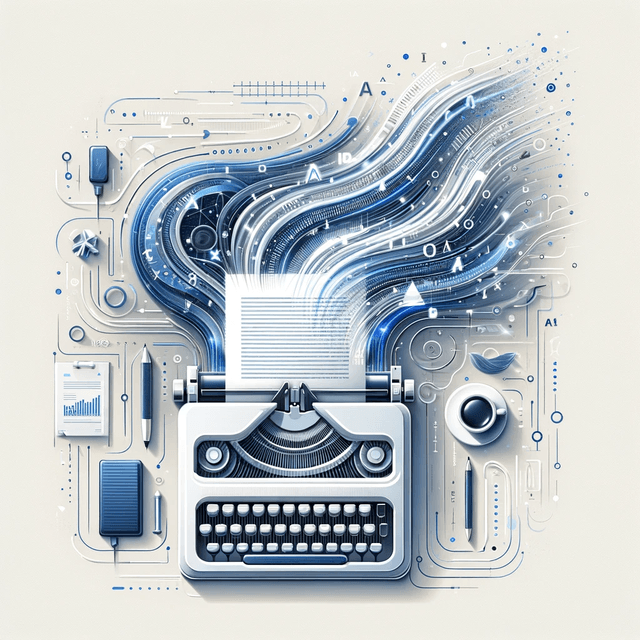
Enhance your writing with Typli's Free AI Writer. Automate and improve your content creation process for blogs, articles, and more.

AI Text Generator
Unleash the power of AI to generate creative and engaging text with Typli's Free AI Text Generator.

AI Paraphrasing Tool
Looking for a reliable paraphrasing tool? Check out our AI-powered solution.

AI Summarizer Tool
Get to the point with our efficient AI summarizer tool.

AI Acronym Generator
Get personalized and original acronyms in seconds with our user-friendly generator tool that's perfect for all your needs.

AI Letter Generator & Writer
Quickly create professional or informal letters using our AI letter generator tool.

Passive to Active Voice Converter
Easily convert passive voice to active voice for a more impactful and engaging writing style.

Bullet Point Generator
Turn your ideas into clear, concise bullet points. Perfect for presentations, lists, and summaries.

AI Image Generator
Generate unique high quality AI images quickly.

AI Speech Writer
Create compelling speeches with our AI speech writer — a tool to craft messages that resonate, from informative and persuasive to motivational and entertaining.

ChatGPT Rewriter
Transform your text with ChatGPT Rewriter - the ultimate tool for rephrasing and paraphrasing content.

Sentence Rewriter
Transform your content with our AI sentence rewriter and create fresh, unique text.

AI Writing Generator
Unleash the power of artificial intelligence to generate high-quality, engaging content with Typli's Free AI Writing Generator. Ideal for bloggers, marketers, and content creators.
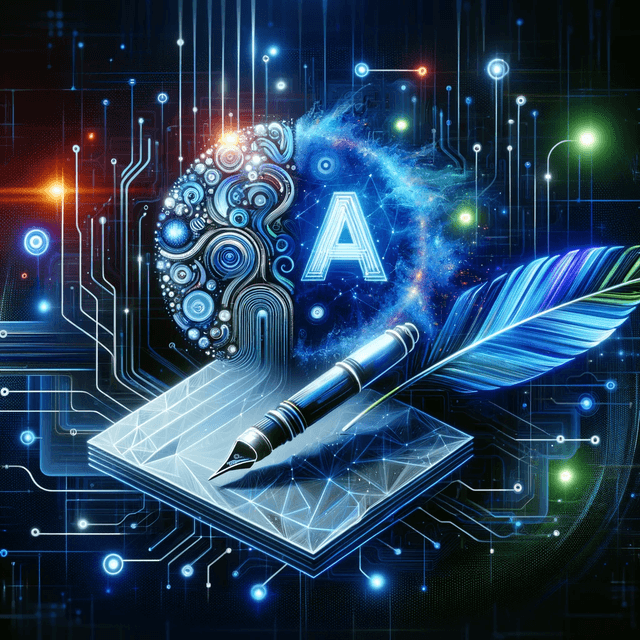
AI Content Generator
Generate compelling, unique content instantly with Typli's Free AI Content Generator. Perfect for blogs, social media, and marketing material.

AI Headline Generator
Instantly generate eye-catching headlines with Typli's Free AI Headline Generator. Perfect for articles, blogs, and marketing campaigns.

Project Name Generator
Generate a creative and unique name for your project. Get name ideas that capture the essence and goals of your project.

Paragraph Rewriter
Produce authentic and captivating content by rewording paragraphs with our rewriter tool.

AI Paragraph Generator
Typli’s AI paragraph generator crafts sentences that flow like a river, delivering smooth, relevant, and surprisingly human paragraphs that get better with each use.

AI Word Expander
Add depth and creativity to your writing with our AI word expander tool for a more sophisticated language experience.

Hook Generator
Uncover the art of writing hooks, headlines, and intros that demand attention from your readers.
Unleashing Positivity: Typli’s AI Inspirational Quote Generator
In a world where positivity is a rare find, Typli’s AI Inspirational Quote Generator shines like a beacon of inspiration. Generating personalized and uplifting messages, this innovative tool is set to revolutionize the way we seek motivation and encouragement. Whether you’re in need of a daily dose of positivity or a boost during challenging times, this AI-powered generator is the uplifting companion you’ve been searching for.
The Power of AI-Generated Motivational Quotes
Imagine starting your day with words of encouragement that feel like they were crafted just for you. That’s the magic of artificial intelligence (AI) stepping into the realm of personal inspiration. By harnessing the latest advancements in AI, we can now receive motivational messages that resonate deeply with our unique situations and emotions. These AI-crafted quotes serve not just to inspire but to provide that personalized nudge sometimes needed to face the challenges of the day with a renewed spirit and a positive outlook.
Understanding the AI Technology Behind the Generator
The intelligence behind this generator is pretty cool – it’s all thanks to some savvy AI, also known as artificial intelligence. This tech is like a recipe, combining natural language processing (NLP) with machine learning. NLP is a special tool that helps computers understand human language. The AI studies tons of motivational quotes and learns what makes them tick.
Once it’s got a handle on that, it starts creating new quotes that feel personal and genuine. It knows how to pick just the right words to hit home. Machine learning means it gets better the more it does it. So every time you see a new quote, it’s based on what the AI’s learned from millions of inspiring messages. It’s all about giving you that push you need, right when you need it.
How Personalized Quotes Cater to Individual Needs and Emotions
Imagine starting your day with a message that feels like it was written just for you. That’s what you get when technology meets the art of personalization. This advanced system isn’t just spitting out random sayings; it’s creating messages that touch the core of your personal experiences and feelings. Imagine a digital companion that knows just what to say to lift your spirits or fuel your drive.
The beauty of customized messages lies in their ability to resonate with you on a deeper level. When a quote speaks directly to your situation, it’s easier to believe in its message and to feel its impact. Emotional connection is key, and this smart technology taps into this by analyzing what makes you tick. From facing a tough day at school to finding the courage to chase your dreams, personalized affirmations offer the right words at the right time, helping you navigate the ocean of emotions with an empowering sail.
Effectiveness of AI-generated motivational quotes in uplifting spirits
Ever feel like you need a pick-me-up to get through the day? Well, the cool thing about today’s tech is that it’s got your back. With AI stepping into the role of a cheerleader, each quote is like a high-five for your soul. These AI-crafted nuggets of wisdom can be a real game-changer when you’re feeling down.
What’s super neat is that they’re tailored just for you, hitting the right notes and lifting your mood in an instant. It’s like having a buddy who knows exactly what to say, anytime, anywhere. So next time you need a boost, remember AI’s got a way with words that’s pretty legit at brightening up your day.
The Impact of Positivity
Positivity isn’t just a feel-good term; it’s a game-changer in our daily lives that has the potential to reshape our mental and emotional landscapes. Embracing a positive mindset means being better equipped to handle the rollercoaster of life, enhancing our resilience and empowering us to chase our goals with gusto.
Boosting Mental Well-Being and Resilience with Encouraging Messages
When times get tough, a few kind words can really turn things around. That’s the simple truth behind the impact of positive affirmations on our mental health. Cheerful messages jump-start our inner resilience, and with today’s tech, personalized encouragements are just a click away. These little nudges of positivity can make a big difference—they’re like having a motivational coach in your pocket, always ready with a pep talk.
Imagine starting your day with an inspiring quote tailored just for you. It might be what you need to tackle a tough project or to bounce back from a setback. Positive messages act as small boosts to your spirit, reinforcing the belief that you can handle life’s hurdles. Over time, they help build a mindset equipped to deal with challenges head-on, fostering a stronger, healthier outlook on life.
Enhancing Productivity and Motivation through Positive Affirmations
In every corner of our busy lives, it’s easy to get bogged down by endless tasks and looming deadlines. Sometimes what we need is a little spark to rekindle our drive and determination. That’s where positive affirmations step in, serving as that tiny yet mighty force to get our gears turning with more energy and purpose.
Motivational sayings are more than just feel-good quotes on a page; they’re psychological tools. By repeating positive affirmations, we can actually rewire our brains to adopt a more empowered and proactive mindset. This, in turn, translates to a more focused and energetic approach to our work and personal goals, pushing us to not only meet but exceed expectations.
Fostering a Culture of Positivity and Encouragement in Various Settings
Creating an environment where encouragement and positivity thrive can have profound effects everywhere, from the classroom to the workplace. A steady stream of uplifting messages not only brightens the atmosphere but also fuels our inner drive to succeed and support each other.
In schools, for instance, instilling such a vibrant culture can boost students’ confidence and academic performance. At work, it can enhance teamwork and productivity, making the office a place everyone looks forward to being part of. This shift towards a supportive setting isn’t simply about feeling good; it’s about building a foundation that elevates everyone’s potential.

Embracing Innovation in Self-Care
Self-care is evolving, and with the dawn of artificial intelligence, it’s taking a leap into the future. Imagine having a personal cheerleader, powered by the latest AI, right in your pocket, ready to offer words of encouragement whenever you need it. This isn’t just about sticking to the same old routines; it’s about adding a new, high-tech twist to the way we look after our mental and emotional health.
Integrating AI Motivation into Daily Self-Care Routines and Habits
Adopting a daily self-care habit is like watering a garden; it fosters growth and blooms. Integrating a touch of AI inspiration into your routine could be the sunlight that brightens even the cloudiest days. Imagine starting your morning with a bespoke, uplifting message waiting on your device, tailored to boost your mood and charge your day with purpose.
By setting reminders or using an app, you can receive daily affirmations that align with your personal goals and challenges. These sparkling nuggets of wisdom can act as a personal cheerleader, reinforcing your strength and determination as you tackle your daily tasks. It’s a seamless way to weave in a strand of positivity into the fabric of your everyday life, turning motivation into a steadfast companion on your journey to wellness.
Exploring the Potential Role of AI-Generated Quotes in Mental Health Support Applications
Artificial intelligence is stepping into the realm of mental health with a unique offering: uplifting words precisely when you need them. With every “You’ve got this!” or “Keep pushing forward!” generated by this smart technology, users could experience a new layer of emotional support. The application of AI in crafting motivational messages opens the door to an innovative form of mental health care that’s both accessible and immediate.
Imagine receiving a daily boost that’s tailored not just to your mood, but also to your personal struggles and triumphs. Mental health applications utilizing artificial intelligence can provide this level of personalized encouragement, potentially enhancing traditional therapies and self-help strategies. By weaving in positivity throughout someone’s day, these tools can become a powerful ally in one’s journey to emotional wellness.
How AI Motivation Aligns with Modern Approaches to Wellness and Personal Development
In this tech-savvy era, embracing AI for self-improvement aligns perfectly with the modern ethos of wellness. Innovative solutions like motivational generators serve as personal cheerleaders, providing real-time encouragement tailored specifically to our unique journeys. They mirror the contemporary focus on personalized care, reinforcing the idea that everyone’s path to personal growth is different.
These smart tools seamlessly integrate with our daily lives, effortlessly becoming part of our routine. Just as we reach for fitness trackers to monitor our physical health, AI motivation fits into the puzzle of mental and emotional care. It supports the holistic view that improving one’s mindset is as crucial as caring for the body, pushing us towards a more balanced and self-aware version of ourselves.
Typli’s AI Motivational Quote Generator is not just a digital tool, but a gateway to a world of endless inspiration and encouragement. Its impact stretches beyond mere words, igniting a flame of positivity in the hearts and minds of all who engage with it. As we embrace the era of AI-driven innovation, let us remember to harness its power for the betterment of our mental and emotional well-being. Through the utilization of Typli’s AI Motivational Quote Generator, we can embark on a journey toward a brighter, more uplifting future.
Step into effortless content creation with Typli and elevate your writing today. Experience AI content writing made simple.
- Writing Worksheets and Other Writing Resources
- Thesis, Analysis, & Structure
Quote Analysis—The Easy Way!
About the slc.
- Our Mission and Core Values

Quote Analysis— The Easy Way!
Just Remember WPAE !
- W riting the quote
- P araphrase
- E valuation
Ways to introduce quotes
When (event in book) happened, (character) states, "..."
Ex: When Lady Macbeth kills herself, Macbeth states, "Life's but a walking shadow, a poor player that struts and frets his hour upon the stage and then is heard no more (V.V.19-20).
(Character) explains: "..." (citation).
(Your own words) "direct quotes from book" ...
Ex: Macbeth pines over his miserable fate, calling life a "walking shadow" (citation).
Ways to paraphrase
Directly look at quote and replace the text with your words. It is vitally important to maintain the same meaning:
Ex: In other words, Macbeth compares his existence to the condition of being a mere ghost. He goes on to compare people to actors who worry about their brief moment in the spotlight only to cease to exist before he realizes his life is over.
Ways to analyze
Look at the subtle parts of the quote, and explain why the author used them in his writing--Tone, diction, mood, figurative language (metaphors, similes, imagery, alliteration, onomatopoeia, personification...there are A LOT).
Ex: The metaphors Shakespeare uses, comparing life to a "walking shadow" and man to "a poor player" emphasize the fleeting nature of life. Shadows are gone as soon as they appear, and actors only assume their character: the people they represent have no true meaning.
Ways to evaluate
Show the importance of the quote with respect to your argument and your thesis. Explain the significance...Tell the reader why they bothered to read your essay. This is where you tie your thoughts together in a nice bow.
Ex: Here, Macbeth realizes that his pitiful existence, from the moment he decided to kill King Duncan to the moment when his beloved wife killed herself, has been consumed by his reckless ambition. This directly shows the damaging power of ambition. If Macbeth had been content with his previous title, which was prestigious enough, a host of tragedy would have been avoided.
When Lady Macbeth kills herself, Macbeth states, "Life's but a walking shadow, a poor player that struts and frets his hour upon the stage and then is heard no more" (V.V.19-28). In other words, Macbeth compares his existence to the condition of being a mere ghost. He goes on to compare people to actors who worry about their brief moment in the spotlight only to cease to exist before they realize it is over. The metaphors Shakespeare uses, comparing life to a "walking shadow" and man to "a poor player" emphasize the fleeting nature of life. Shadows are gone as soon as they appear, and actors only assume their character: the people they represent have no true meaning. Here, Macbeth realizes that his pitiful existence, from the moment he decided to kill King Duncan to the moment when his beloved wife killed herself, has been destroyed by his reckless ambition. This directly shows the damaging power of ambition, a major theme of the play. If Macbeth had been content with his previous title, which was prestigious enough, a wealth of tragedy would have been avoided.
Write your thesis here for reference:
1. Write the quote here, with a way to introduce it:
2. Write a paraphrase here (remember to keep the same meaning):
3. Write your analysis here (look for the subtle, key parts of the quote):
4. Write your evaluation here (prove why the quote is important in relation to your thesis):
5. Repeat for the rest of your text-based essay!!!
Sarah Cohen
Student Learning Center, University of California, Berkeley
©2009 UC Regents
This work is licensed under a Creative Commons Attribution-NonCommercial-NoDerivs 3.0 Unported License.
Thank you for visiting nature.com. You are using a browser version with limited support for CSS. To obtain the best experience, we recommend you use a more up to date browser (or turn off compatibility mode in Internet Explorer). In the meantime, to ensure continued support, we are displaying the site without styles and JavaScript.
- View all journals
- Explore content
- About the journal
- Publish with us
- Sign up for alerts
- NEWS EXPLAINER
- 09 December 2022
AI bot ChatGPT writes smart essays — should professors worry?
- Chris Stokel-Walker
You can also search for this author in PubMed Google Scholar
Between overwork, underpayment and the pressure to publish, academics have plenty to worry about. Now there’s a fresh concern: ChatGPT , an artificial intelligence (AI) powered chatbot that creates surprisingly intelligent-sounding text in response to user prompts, including homework assignments and exam-style questions. The replies are so lucid, well-researched and decently referenced that some academics are calling the bot the death knell for conventional forms of educational assessment. How worried should professors and lecturers be?
Access options
Access Nature and 54 other Nature Portfolio journals
Get Nature+, our best-value online-access subscription
24,99 € / 30 days
cancel any time
Subscribe to this journal
Receive 51 print issues and online access
185,98 € per year
only 3,65 € per issue
Rent or buy this article
Prices vary by article type
Prices may be subject to local taxes which are calculated during checkout
doi: https://doi.org/10.1038/d41586-022-04397-7
Reprints and permissions
Related Articles

Are ChatGPT and AlphaCode going to replace programmers?
How language-generation AIs could transform science
Open-source language AI challenges big tech’s models
- Computer science

AI now beats humans at basic tasks — new benchmarks are needed, says major report
News 15 APR 24

High-threshold and low-overhead fault-tolerant quantum memory
Article 27 MAR 24
Three reasons why AI doesn’t model human language
Correspondence 19 MAR 24

Neglecting sex and gender in research is a public-health risk
Comment 15 MAY 24
Interpersonal therapy can be an effective tool against the devastating effects of loneliness
Correspondence 14 MAY 24
Inequality is bad — but that doesn’t mean the rich are

Reading between the lines: application essays predict university success
Research Highlight 17 MAY 24

How to stop students cramming for exams? Send them to sea
News & Views 30 APR 24

How young people benefit from Swiss apprenticeships
Spotlight 17 APR 24
Postdoc in CRISPR Meta-Analytics and AI for Therapeutic Target Discovery and Priotisation (OT Grant)
APPLICATION CLOSING DATE: 14/06/2024 Human Technopole (HT) is a new interdisciplinary life science research institute created and supported by the...
Human Technopole
Research Associate - Metabolism
Houston, Texas (US)
Baylor College of Medicine (BCM)
Postdoc Fellowships
Train with world-renowned cancer researchers at NIH? Consider joining the Center for Cancer Research (CCR) at the National Cancer Institute
Bethesda, Maryland
NIH National Cancer Institute (NCI)
Faculty Recruitment, Westlake University School of Medicine
Faculty positions are open at four distinct ranks: Assistant Professor, Associate Professor, Full Professor, and Chair Professor.
Hangzhou, Zhejiang, China
Westlake University
PhD/master's Candidate
PhD/master's Candidate Graduate School of Frontier Science Initiative, Kanazawa University is seeking candidates for PhD and master's students i...
Kanazawa University
Sign up for the Nature Briefing newsletter — what matters in science, free to your inbox daily.
Quick links
- Explore articles by subject
- Guide to authors
- Editorial policies
Offer of the decade FLAT 20% off + sign up bonus of $20 Order Now
- [email protected]
- +14159918581
Files Missing!
Please upload all relevant files for quick & complete assistance.
Put a Quote in an Essay
Home / Blog / How To Put A Quote In An Essay (with Examples)

Introduction
When writing an essay , it is essential to incorporate quotes from reputable sources to support your arguments and ideas. However, knowing how to use quotes effectively is crucial in maintaining the flow and clarity of your essay. This blog will discuss the proper ways to put a quote in an essay with examples.
Why Use Quotes in an Essay?
Quotes are used in an essay to support or reinforce the writer's arguments and ideas. They provide evidence for your claims and demonstrate that your argument is backed up by research and authority. Incorporating quotes also helps to provide context and depth to your writing and can add a unique perspective to your essay.
Types of Quotes
There are two types of quotes you can use in your essay: direct quotes and indirect quotes.
Direct Quotes: Direct quotes are the exact words used by the source that you are quoting. When using direct quotes, you need to use quotation marks and indicate the source.
Example: According to John Smith, "The Earth is round."
Indirect Quotes: Indirect quotes are a paraphrase of the original source. When using indirect quotes, you do not need to use quotation marks.
Example: John Smith claims that the Earth is round.
How to Put a Quote in an Essay
When using quotes in an essay, there are several rules that you need to follow to ensure that your writing is clear, accurate, and appropriate. Here are the steps to follow:
Step 1: Choose a Relevant Quote
Before you start writing your essay, identify the quotes that you want to use to support your arguments. Ensure that the quotes you select are relevant, reliable, and add value to your essay.
Step 2: Introduce the Quote
Introduce the quote by providing context and indicating who the source is. This will help the reader understand the significance of the quote and its relevance to your argument.
Example: According to Jane Doe, a renowned climate scientist, "Climate change is the biggest threat facing humanity."
Step 3: Use Quotation Marks
When using a direct quote, use quotation marks to indicate that you are using the exact words of the source.
Example: According to Jane Doe, "Climate change is the biggest threat facing humanity."
Step 4: Provide the Source
Provide the source of the quote, including the author's name, the title of the book or article, and the page number. This will help the reader find the source if they want to read it.
Example: According to Jane Doe, a renowned climate scientist, "Climate change is the biggest threat facing humanity." (Doe, The State of the Climate, p. 25)
Step 5: Punctuate Correctly
Punctuate the quote correctly by placing the comma or period inside the quotation marks, depending on whether it is a part of the quote or your sentence.
Step 6: Explain the Quote
Explain the significance of the quote in your own words. This will help the reader understand how the quote supports your argument.
Example: Jane Doe's quote highlights the urgency of addressing climate change as it poses a significant threat to human survival.
Step 7: Cite Your Sources
Ensure that you cite your sources correctly using the citation style specified by your instructor or the style guide for your discipline.
Common Mistakes to Avoid When Using Quotes in an Essay
Using quotes in an essay can be tricky, and many students make mistakes that can impact the quality of their writing. Here are some common mistakes to avoid when using quotes in an essay:
Failing to provide context: It is essentialto provide context when using a quote in an essay. Failure to do so can confuse the reader and make the quote appear out of place. Always introduce the quote and provide some background information about the source and why you are using the quote.
Overusing quotes: While quotes can add value to your essay, it is essential not to overuse them. Use quotes sparingly and only when necessary. Overusing quotes can make your writing appear lazy, and it may give the impression that you are not confident in your own ideas.
Incorrectly citing sources: Always cite your sources correctly using the citation style specified by your instructor or the style guide for your discipline. Failure to do so can lead to accusations of plagiarism , which can have serious consequences.
Misquoting or altering a quote: When using a direct quote, it is essential to use the exact words of the source. Do not alter the quote or misquote the source as this can distort the meaning and accuracy of the quote.
Failing to explain the quote: When using a quote, it is important to explain its significance and how it supports your argument. Failure to do so can make the quote appear irrelevant and disconnected from your essay.
Examples of Quotes in an Essay
Here are some examples of how to use quotes in an essay:
Example 1: Argumentative Essay
Topic: Should students be required to wear school uniforms?
Quote: "School uniforms promote a sense of unity and equality among students, and they help to reduce instances of bullying based on clothing." (Johnson, School Uniforms, p. 10)
Explanation: The quote supports the argument that school uniforms can have a positive impact on student behavior and reduce instances of bullying. It is introduced with the source and provides context for the argument.
Example 2: Persuasive Essay
Topic: The importance of recycling
Quote: "Every ton of paper that is recycled saves 17 trees, 7,000 gallons of water, and 463 gallons of oil." (Environmental Protection Agency)
Explanation: The quote provides a powerful statistic that supports the importance of recycling. It is introduced with the source, and its significance is explained in the following sentences.
Example 3: Expository Essay
Topic: The history of the American Civil War
Quote: "Four score and seven years ago, our fathers brought forth on this continent, a new nation, conceived in Liberty, and dedicated to the proposition that all men are created equal." (Lincoln, Gettysburg Address)
Explanation: The quote is an iconic line from Abraham Lincoln's Gettysburg Address, which is a significant event in American history. It is introduced with the source, and its significance is explained in the following sentences.
Incorporating quotes in an essay can add depth, context, and authority to your writing. However, it is important to use quotes effectively and appropriately. Always choose relevant and reliable quotes, introduce them with context, use the correct punctuation, explain their significance, and cite your sources correctly. By following these guidelines, you can effectively use quotes in your essay and improve the quality of your writing.
Do you want to share?
You might also like.

Top 100 Persuasive Essay Topics/Ideas for Students

Discursive Essay Topics for Students

How to Write an Essay Introduction?

How to Write a Law Essay: Writing Guide with Examples

How to Choose Ideal Argumentative Essay Topics to Work On

PEEL Paragraph a Guide to Write a Perfect Essay

100 Effective Persuasive Essay Topics

How to Write a Descriptive Essay?- Guide with Examples

Who Am I Essay : How to Write it?
Leave a reply, place order.
Want Impressive Essay Help?
Submit your requirements here

-->Admin --> Published On Oct 3, 2023 | Updated on Oct 4, 2023

-->Admin --> Published On Sep 30, 2023 | Updated on Sep 30, 2023

-->Admin --> Published On Sep 26, 2023 | Updated on Sep 26, 2023

-->Admin --> Published On Sep 22, 2023 | Updated on Sep 26, 2023

-->Admin --> Published On Sep 5, 2023 | Updated on Sep 11, 2023
Assignment Help
Dissertation
Research Paper

-->Admin --> Published On Apr 18, 2019 | Updated on Aug 10, 2023

-->Admin --> Published On Sep 22, 2018 | Updated on Sep 12, 2023

-->Admin --> Published On Feb 13, 2019 | Updated on Aug 10, 2023

-->Admin --> Published On Apr 5, 2023 | Updated on Aug 10, 2023

-->Admin --> Published On Jun 22, 2020 | Updated on Aug 10, 2023
Subscribe Newsletter
You can place your order for free now. Simply submit your order and see what our writers can Subscribe to get regular update!
Thank you for commenting.
Thank you for subscribed newsletter.
Thank You For Commenting.
Get acquainted with the top essay helpers in the country and glide smoothly towards your academic goals with the necessary essay writing help online from US’s top professionals.
Want quick $20? Share your details with us.
Thank you for subscribing our newsletter
Have any Query? Contact with us

7 Best Ways to Shorten an Essay
- Smodin Editorial Team
- Published: May 14, 2024
Are you removing a lot of words and paragraphs from your essay but still not seeing the word count budge? Whether you’re meeting a strict word count or refining your message, reducing your essay’s length without sacrificing content quality can be challenging.
Luckily, besides just aiming for the minimum word count, there are some pretty simple solutions, like using artificial intelligence, conducting thorough research, and trimming unnecessary words. But there’s more.
In this guide, we’ll unpack some practical tips to help you make your essay concise and impactful. Time to make every word count!
7 Best Ways To Shorten an Essay
Here’s a detailed breakdown of the best ways you can shorten your essay:
1. Use Artificial intelligence
When we talk about academic writing, artificial intelligence (AI) can be a game changer, especially when it comes to reducing the length of your essays.
Tools like Smodin can help make your content more concise while enhancing overall quality. AI can help you shorten your essay through the following methods:
- Automated rewriting : AI rewriting tools can reformulate existing content to make it more straightforward while maintaining the original meaning.
- Sentence simplification : Algorithms can analyze your sentences and suggest simpler alternatives, helping eliminate redundant information and reduce word count.
- Research assistance : Certain platforms have AI-powered research tools that allow you to quickly gather the most relevant information. This ensures that every word in your essay contributes to your argument without unnecessary fillers.
- Plagiarism check : Ensuring your essay is plagiarism-free is crucial. For example, Smodin’s plagiarism detection tools help you identify and replace copied content with original, concise expressions.
- Instant feedback : Receive real-time suggestions on how to streamline your text, focusing on the essentials to effectively communicate your message.
- Reference generation : Automatically generate and insert citations in the correct format, which helps save you time while maintaining the academic integrity of your essay and keeping it short.
2. Identify Unnecessary Words and Remove Them
One of the simplest yet most effective ways to shorten your essay is by identifying and eliminating unnecessary words.
This approach helps decrease word count and sharpens your arguments, making your writing more compelling. You can identify and remove extra words by doing the following:
- Spot wordy phrases : Often, phrases can be condensed without losing meaning. For example, the phrase “due to the fact that” can be replaced with “because.” Be on the lookout for wordy phrases that increase word count needlessly.
- Remove unnecessary prepositional phrases : Prepositional phrases can be redundant or add unnecessary detail. Evaluate whether these phrases add value or just extra words. Cutting them can make sentences more direct.
- Avoid redundancies : Redundant pairs like “absolutely essential” or “future plans” can be reduced to one word without losing informational value.
- Trim excess adjectives and adverbs : Adjectives and adverbs can make writing better but can also lead to over-description. Use them sparingly, especially when they don’t contribute additional meaning to the nouns and verbs they modify.
- Fewer words; more impact : Aim for brevity by using fewer words to express the same idea. This will help to reduce the word count while making your writing more impactful and clear.
3. Tighten Sentence Structure
Tightening your sentence structure is crucial for making your essay more concise and readable. Use active voice to make your writing clearer and more dynamic. This is especially important in academic writing, where you have to get to the point quickly.
In academic essays, shifting from passive voice to active voice can shorten and strengthen your sentences. For example, instead of writing, “The experiment was conducted by the students,” you can say, “The students conducted the experiment.” This reduces the number of words and places the action directly with the subject, making your sentences more direct.
Combining two separate sentences into one can streamline your ideas and reduce redundancies. Look for opportunities where sentences can be merged without losing their significance. For example, “He wrote the book. It became a bestseller.” can be rephrased as “He wrote the book, which became a bestseller.”
Also, avoid unnecessary qualifiers and modifiers that don’t add substantial information. Sentences often become bogged down with these extras, making them cluttered and long.
4. Conduct Thorough Research
When writing essays, extensive research can make the final output a lot shorter. Effective research helps you gather precise information that’s relevant to your topic. This means you’ll write more directly and avoid needless elaboration. Here’s how you can conduct research effectively:
- Define the scope of your research : Determine what information is essential to the argument. This initial step will help you focus your research efforts and prevent irrelevant data.
- Identify key sources : Begin with scholarly databases and academic journals that offer peer-reviewed articles. These sources provide credible, authoritative information that can be crucial for academic writing.
- Use precise keywords : When searching for information, use specific keywords related to your essay topic. Precision here will help find the most relevant articles and studies, reducing time spent on unnecessary reading.
- Evaluate sources : Assess the relevance and reliability of each source. Check the publication date to ensure the information is current and relevant to your topic.
- Take notes efficiently : As you research, jot down important points, quotes, and references. Organize these notes according to the sections in your essay to make writing faster.
- Synthesize information : Combine information from multiple sources to build a strong argument. This will allow you to write comprehensively and with fewer words, as each sentence carries more weight.
5. Improve Your Paragraph Structure
Streamlining paragraphs can make your essay shorter and more digestible for the reader. With a well-structured paragraph, you can focus on a single idea supported by concise statements.
Begin each paragraph with a topic sentence that clearly states the main idea. This sentence sets the direction and tone, letting the reader know what to expect. It also helps ensure that every following sentence relates directly to the main idea.
Condense supporting information by merging ideas that logically coexist within a single sentence or phrase. After that, evaluate each sentence for its contribution to the paragraph’s main idea. Remove any information that is repeated or goes into too much detail.
Focus on providing evidence and explanations that directly support the main point. You should also end each paragraph with a sentence that reinforces the main idea and potentially links to the next paragraph. This creates smooth transitions and keeps the essay focused and cohesive.
6. Refine the Introduction and Conclusion
These sections frame your essay and influence how your arguments are perceived. Here are some ways to keep them concise yet effective.
Introduction
The introduction should be engaging and concise, clearly stating the purpose and scope of your essay. Begin with a hook that grabs the reader’s attention, followed by background information that sets the context. Incorporate your thesis statement early on, ideally at the end of the intro.
The conclusion needs to reinforce the thesis. Summarize key points in the essay and show how they support the thesis. Provide a final thought that leaves the reader with something to ponder.
Also, remember to keep it tight – the conclusion isn’t a place for introducing new ideas. It should wrap up the ones you presented and prompt the reader to pose their own questions.
7. Edit and Proofread
Keep your essay concise and error-free by allocating ample time for editing and proofreading. These processes scrutinize your work at different levels, from the overall structure to word choices and punctuation. Here’s how you can go about it:
Start by reading through your entire paper to get a feel for its flow and coherence. Check if all paragraphs support your thesis statement and if section transitions are smooth. This will help you spot areas where the argument might be weak, or wording could be clearer.
Focus next on paragraph structure. Ensure each paragraph sticks to one main idea and that all sentences directly support the idea. Remove any repetitive or irrelevant sentences that don’t add value.
Then, look for clarity and style. Replace complex words with simpler alternatives to maintain readability. Keep your tone consistent throughout the paper. Adjust the sentence length and structure to enhance the flow and make it more engaging.
Proofreading
Proofreading comes after editing. The focus here is catching typing errors, grammatical mistakes, and inconsistent formatting. It’s always best to proofread with fresh eyes, so consider taking a break before this step.
Use tools like spell checkers, but don’t rely solely on them. Read your essay aloud or have someone else review it. Hearing the words can help you catch errors you may have missed.
Lastly, check for punctuation errors and ensure all citations and references are formatted according to the required academic style. This and all of the above are areas in which AI can help get the job done with speed and precision.
Why You Might Need to Shorten Your Essay
Ever heard the expression “less is more”? When it comes to academic writing, it normally is. Keeping your essays concise offers several benefits:
- Enhances clarity : A shorter essay forces you to focus on the main points and critical arguments, reducing the risk of going off-topic. This clarity makes your writing more impactful and easier for the reader to follow.
- Meets word limits : Many academic assignments have a maximum word count. Learning to express your thoughts concisely helps you stay within these limits without sacrificing essential content.
- Saves time : For both the writer and the reader, shorter essays take less time to write, revise, and read. This efficiency is especially valuable in academic settings where time is usually limited.
- Increases engagement : Readers are more likely to stay engaged with a document that gets to the point quickly. Lengthy texts can deter readers, especially if the content has unnecessary words or redundant points.
- Improves writing skills : Shortening essays helps refine your writing skills. You become better at identifying and eliminating fluff, focusing instead on what really adds value to your paper.
Overall, adopting a more succinct writing style helps you meet academic requirements and polish your communication skills.
Why Use Smodin To Shorten an Essay
Using AI-powered platforms like Smodin to shorten your essay is both the simplest and the least time-consuming method available. Here’s why you should probably make Smodin your go-to essay shortener:
- Efficiency : Smodin eases the editing process, using advanced algorithms to quickly identify areas where content can be condensed without losing meaning.
- Accuracy : With its powerful AI, Smodin ensures that the essence of your essays stays intact while getting rid of unnecessary words, making your writing more precise.
- Ease of use : Smodin is user-friendly, making it accessible even to those who aren’t the most tech-savvy. Its easy-to-grasp interface allows for seamless navigation and operation.
Smodin’s offerings
- Rewriter : Available in over 50 languages, this tool helps rewrite text to be more concise.
- Article Writer : Assists in drafting articles that are crisp and to the point.
- Plagiarism and Auto Citation : Ensures your essay is original and correctly cited, which is crucial in academic writing.
- Language Detection : Identifies the language of the text, ensuring the right adjustments are made for clarity.
All these tools and more are what make Smodin an excellent choice for academics looking to reduce the length of their essays.
Final Thoughts
Word counts can be a real headache, especially when you need to say a lot with a little. Thankfully, by identifying unnecessary words, tightening your sentences, and using tools like Smodin, you can make your essay concise without losing its meaning. Remember, a shorter essay doesn’t just meet word limits; and it’s clear, more compelling, and more likely to keep your reader engaged.
Keep it short, keep it sweet, and make every word count! Get started for free right now with Smodin.

May 6, 2024 Accountancy Alumni Business Administration Faculty Finance Student
Implementing AI technology in business education
By embracing a spirit of experimentation, we can view the changes that lie ahead for our industry with optimism instead of trepidation.
By Robert Brunner
- Artificial intelligence platforms might not yet produce responses that we would mistake as human-generated, but they are learning and growing more sophisticated by the day.
- To prepare students for the future of AI, faculty at Gies College of Business ask students to use AI platforms for certain assignments and then discuss what prompts their peers used to receive their results.
- Faculty also are experimenting with the technology themselves on tasks such as grading and writing quizzes, so that they are prepared to integrate AI into their teaching.

The climate of higher education has been undergoing great upheaval over not just the past few years, but the past few months . In particular, we have seen the quick adoption of ChatGPT and the vast changes this technology has inspired in our courses.
As with many past disruptive technologies, ChatGPT has inspired great uncertainty, even fear and trepidation, among faculty. But I don’t think these are appropriate responses. On the contrary, I look upon these changes with a sense of optimism. And excitement. I believe that, as academics, we must take to heart the quote often ascribed to management guru Peter Drucker: “Innovate or die.”
With that idea in mind, I want to share my experiences and those of my colleagues here at Gies College of Business at the University of Illinois Urbana–Champaign. Our approach to adopting artificial intelligence (AI) illustrates how we can embrace new technologies and prepare students for what they will encounter in their future careers.
A Career Foc used on ‘What’s Next’
My background is perhaps quite different from many people who teach business courses. It has been one of using technology, embracing innovation, and celebrating curiosity.
I am currently the associate dean for innovation, chief disruption officer, and professor of accountancy at Gies Business. But my academic training was not in business; it was in astronomy. I started my career by working on the Sloan Digital Sky Survey , a long-term project that mapped a large fraction of the night sky. During this experience, I worked primarily with big data and machine learning. Later, I accepted a position as a professor in the Department of Astronomy at the University of Illinois, where I also worked with the National Center for Supercomputing Applications .
In 2017, I moved to Gies College of Business because I thought its programs provided a unique opportunity. Business school administrators and educators could use the university’s strengths in science, technology, engineering, and mathematics (STEM) as opportunities to really think about what is over the next hill. We could explore important questions, such as what major impacts forthcoming innovations will have on business and society. As director of the University of Illinois–Deloitte Foundation Center for Business Analytics at that time, I could contribute to how our college was educating its students and preparing its stakeholders for the future.
Originally, my role centered primarily around data analytics. But even then, administrators at Gies were thinking about bigger opportunities that were starting to take shape.
What Do We Mean by Artificial Intelligence?
Now, as the college’s chief disruption officer, I’m helping faculty make sense of the impact that other disruptive technologies, such as AI, are having on business. As we discuss the implications and capabilities of AI, it’s natural that we evaluate it through the lens of human intelligence. Consider the people we know or meet during the day. Through our interactions with them, can we gauge their levels of intelligence? Can we know, based on our perceptions of their intelligence, what it means for them to be human?
For this, people most often look to the Turing Test, which was actually called the imitation game by creator Alan Turing. Simply stated, the test asks a human being to converse with both an artificial entity such as a computer and another human, separated from each by a wall. If the human test subject cannot differentiate the responses of the AI from those of the human, we would consider that AI to be intelligent.
We are now in our own 21st-century version of the Turing Test as we interact with ChatGPT. Such platforms promise to be the most impactful technologies we have seen in recent times.
The Usefulness of ChatGPT
We can consider AI technology from two different perspectives. First, we can view its interactive interface as an amazing way to converse with some sort of artificial intelligence. In this respect, it does seem to be approaching the point of “winning” Turing’s imitation game.
Second, we can recognize that ChatGPT is a generative tool based on a large language model (LLM) that has been “trained” by scraping a huge amount of data from the internet. When we type prompts into interfaces such as ChatGPT, the AI then uses that text to start inferring its answer. When we see the answer, we can give it a thumbs up or thumbs down on how well it answered our prompt. The system will use this feedback to continue to improve the LLM over time, not just for each individual user but for the entire population of people using the same model.
In other words, ChatGPT is basically a propagating, self-training imitation game that’s just going to keep getting better at answering questions more quickly, in ways that make users happy. And this is just the beginning. We are already seeing new ways to interact with LLMs via audio and video in multimodal interactions that closely imitate how humans interact with each other.
Eventually, I believe these types of technologies will blend into the background as they become ingrained into our everyday life, in much the same way as email, text messages, web search, or social media are now no longer considered magical . The next step in the technology’s evolution could involve wearable devices that record our lives to allow an AI to help us deal with information in new and more powerful ways.
Teaching With AI
At Gies, I created an emerging technology course that I now have taught for the last four years. I tell each cohort of students that we are not teaching them to predict the future—that’s a fool’s errand. Instead, we are trying to teach them how to predict possible scenarios. If they know what the possible scenarios are, they can better prepare themselves—and their companies—for those outcomes.
The course is built so that the students don’t just learn about these emerging technologies; they actually must use them as part of their assessments. Thus, we teach the students what AI can and can’t do. We ask students to use AI such as ChatGPT to develop answers for some assignments, as part of the assignment rubric.
However, we don’t want them to just use an AI platform once and say, “Here’s my essay.” Instead, we require them to examine the process of using the technology. What prompts did they use? How did changing the prompts change the responses they received? How much do they trust those responses?
To help them answer these questions, we include peer grading in these assignments. In this case, it’s not about grading someone else’s work as much as it’s about seeing how different students approached the problem at hand. It can be extremely useful for students to know what prompts their peers used to receive their results.
Other faculty at Gies College are also bringing AI into their courses. For example, in IT for Networked Organizations, my colleague Vishal Sachdev developed a bot to serve as a support to students. It is intended to act like a member of the classroom, but with better memory. Based on the course syllabus, this bot helps students become familiar with the basic outline of the course.
Next, Sachdev developed a new bot with the same back-end infrastructure as the first. He trained this one with assignment instructions, a model submission, a rubric, and guidelines on how to respond to students. This bot can provide critiques to student submissions, feedback on possible missing elements in assignments and problems with word length, and guidance on whether students have sufficiently answered the assignment’s question.
We also have a Teaching and Learning team that supports both our in-person and online programs, examines available educational technologies, and provides faculty with guidance and leadership on how the newest edtech can be brought into the classroom. For the past couple of years, in conjunction with our Disruption Lab, our Teaching and Learning team has hosted monthly Zoom coffee hour meetings called Teaching with Innovative Technologies. During these meetings, Gies faculty share their experiences implementing specific technologies, including AI, in their courses—whether they’ve streamlined their grading with AI or have used chatbots to engage their students. These conversations are opportunities for our faculty to discuss the benefits AI tools can bring to the classroom.
Tips and Techniques
There are a few things I would suggest to others who are interested in bringing AI into their classrooms:
Know that there is a learning curve. Using an AI interface is not as simple as typing text into a Word file. At least not yet. You’ve probably heard about prompt engineering, which is crafting the best prompt to get ChatGPT to write something that is as close as possible to what you want. Many people are out there offering to teach people how to get better at this, but we have to be careful—not all of this training is relevant to higher education, or even useful.
Be willing to experiment. You likely will fail at the start, but don’t stop testing the boundaries of the technology. The beauty of using these tools is that they don’t complain if you ask them to do the same thing over and over. To get good at using AI platforms, you’re going to have to spend time with them to understand how they work and learn how to use them in your courses.
Don’t be afraid to try it in unexpected contexts. AI might be of value in areas where you thought it wouldn’t be helpful! One thing that most surprised me was how well—and how amazingly quickly—these tools could generate quiz questions based on content that I wrote for the course. This addresses one of the tasks I find to be the biggest drudgery of teaching: creating quizzes. Now, I can use ChatGPT (or another AI tool) to create 25 questions, and then I can pick the best 10 questions and edit them as needed.
With a little prompt engineering, you can customize the results. You can tell ChatGPT that you want two answers that are right, or you can ask it to generate one right answer along with an explanation tailored to the level of your students. It also will generate different answers with potential rubrics and explanations for why each answer is correct. Used this way, the tool provides a huge time savings.
Be open to new possibilities. If you think about it, it’s really amazing what generative AI platforms can do. But if you’re not open to trying them in new ways, you miss the opportunities and risk missing out.
Bigger Things on the Horizon
As academics, we must be open to even bigger things coming. Earlier, I mentioned AI video generation. While it’s not to the point that I would blindly trust AI to create new video content, we are using it to create opening videos for a MOOC I am preparing. And we are starting to look at how AI can be used to translate existing video content into new languages, all while maintaining my voice and mannerisms.
In the end, we must work with these technologies ourselves to prepare our students for the new business world to come. If our students aren’t ready for what the future holds, they could quickly become obsolete in important ways that we may not fully understand right now.
The takeaway is, if we as faculty are not staying abreast of disruptive technologies such as AI, we will face an even bigger task down the line. In short, as the famous quote says, innovate or die.
AUTHOR Robert Brunner , Associate Dean for Innovation and Chief Disruption Officer and Professor of Accountancy, Gies College of Business, University of Illinois Urbana-Champaign
More Articles
Bobbie’s Bests for Less: 50% off handbags, skin care, more
- TODAY Plaza
- Share this —

- Watch Full Episodes
- Read With Jenna
- Inspirational
- Relationships
- TODAY Table
- Newsletters
- Start TODAY
- Shop TODAY Awards
- Citi Concert Series
- Listen All Day
Follow today
More Brands
- On The Show
After 20 years, I met my childhood hero: The local news anchor who looked like me

This story was first published on May 28, 2021.
If you ask kids who their childhood heroes are, they’ll probably mention characters and celebrities they see on-screen. If you’re my age (turning 30 this summer, despite not fully being ready for it ), you might remember looking up to the Power Rangers or Britney Spears.
I, however, looked up to Ellee Pai Hong.
That’s not an obscure actor’s name or an early ‘90s pop star that slipped your mind; Ellee Pai Hong was the morning news anchor on NBC Chicago in the early-mid 2000s.
My mother has faithfully watched the TODAY Show and the morning local news every day in our suburban Chicago home since before I was born. She still does, actually, and wants Al Roker to know that he should go easy on Craig Melvin.
It’s a matter of luck or fate that I now work for TODAY, the show I have genuinely watched since birth, and Ellee Pai Hong was the person I saw each morning before catching the bus. There were a few days I didn’t tune in — I was tired, running late, finishing some sort of homework — but most days, I watched attentively as a well-dressed Asian American woman delivered the news in my hometown.
As anyone who is a devout watcher of morning news will tell you, it’s easy to grow attached to the anchors who you welcome into your home each day. For me, it wasn’t just that Ellee Pai Hong was cool and funny — though she obviously was — it was that she was one of the few faces that looked like mine on TV at the time.

I soon discovered that my life skills involved, almost exclusively, talking to others and writing, so I decided to pursue a career in journalism. And I can safely say that I believed I could follow my dreams, at least in part, because I had watched Ellee Pai Hong do it for all those years.
When I stepped foot on campus at the University of Missouri, which is home to one of the nation’s best journalism programs, I had a bit of culture shock. People there were constantly asking me “What are you?” and the only other Asian faces I recognized were exchange students coming to study from the other side of the globe. I wasn’t sure where I fit in.
Later, as a reporter/anchor on the local NBC station in Columbia, Missouri, I took phone calls, emails, tweets and comments from local viewers who complained about my appearance on air. And at least some of the responses were tied to my ethnic identity .

But through it all, I tried to channel the journalists who came before me, especially Ellee Pai Hong.
I decided to track her down for this piece to let her know just how much her presence and success meant to me. She was kind enough to chat with one of her biggest fans and shared that she still works in TV, serving as a host for Comcast Newsmakers .
It turns out that while growing up in Los Angeles, she looked up to another Asian American newscaster. Hong told me she used to trick her two sisters into watching the afternoon news so she could catch KCBS anchor Tritia Toyota.
“We only had one TV … and they never wanted to watch news,” she said with a laugh. “I’d say, ‘Well, don’t you want to watch the weather so you can figure out what you’re wearing to school tomorrow?’”
Toyota actually co-founded the Asian American Journalists Association in 1981. (Disclaimer: I’m a member of AAJA, which is now a nationwide organization with more than 1,500 members across the country).
“That’s who I used to watch, and I’d be like, ‘Oh, that looks interesting,’” Hong said. “And to see someone doing something like that (who) looks like me made it possible in my head. I totally believe you need to see people in different like diverse people in different areas because it connects you with that job or career.”
She added that she didn’t realize until later that she wanted to go into television broadcasting herself.
“Honestly, I wanted to be a Broadway star,” she said with a chuckle. “I’ve always been a little bit of a ham. But I realized I’m not that great of a singer.”

Like anyone meeting their career role model, I also had to ask for Hong’s professional advice.
Her first tip was to approach stories from all angles. She explained that her first boss (a “hardass”) in a small local news market had made her approach a family grieving after their two children died in a fire. Hong said she didn’t want to do the story but felt pressure from her boss, so asked the mother to tell her about her children’s lives before their untimely deaths.
“I took the position of, you know, let’s talk about your children, how great they were. Tell me about all the great stuff they did and what kind of kids they were and how much you love them” she said. “Just like with everything, it’s about how you approach things. Don’t get stuck in thinking you need to approach things one way — you can come at it from all different angles.”
Another piece of advice: “You’ve got to manage up, as well as manage down,” referring to how important it is to maintain workplace relationships with both subordinates and those you report to.
“Obviously … being good is just the baseline, you have to be good at what you do,” she said.“But you have to manage those relationships within your workspace … it’s always people problems, relationship problems that gets in the way of being more productive and more creative.”
As of late, there have been a slew of problems facing the Asian American community . As I spoke with Hong in late April, there were ongoing attacks against people of Asian descent happening across the country.
Hong told me a story about how her daughter had faced racism at school and how she’d coached her to stick up for herself. She thinks the entire community should come together to stand up for themselves as well and hopes for lasting change.
“I feel like Asian Americans, we need a person or a group or several people to say something and be loud about it,” she said. “Culturally speaking, we as Asian Americans, we grow up to be considerate of others. It’s not ‘me first,’ it’s consideration of others, work hard and do what you’re supposed to do.
“But, you know, silence never inspired change, right, so to be silent about what happens to you, about the derogatory comments that are aimed at you, about the hate crimes — more seriously — that happened to you, it doesn’t do anything,” she continued. “It doesn’t prompt change so I feel like as a community, we cannot be silenced. And we cannot be silent.”
Sam Kubota is a senior digital editor and journalist for TODAY Digital based in Los Angeles. She joined NBC News in 2019.

How American landowners overthrew the Hawaiian monarchy and forced US annexation

How a plush toy helped get South Asian women talking about infertility

25 AANHPI Heritage Month quotes that will inspire you this May

K-pop group ENHYPEN is growing up — together

A baker is serving up the history of notable Asian Americans, one cookie at a time

AANHPI Heritage Month: The history of the month-long celebration

For 23 years, I was Caroline. Here’s why I reclaimed my Chinese birth name.

120 years and counting: How this mochi shop has been keeping the Japanese tradition alive since 1903

Kristi Yamaguchi won Olympic gold 32 years ago. Her latest prize: Becoming a Barbie doll

How I chose my kids' Indian names so my husband could pronounce them
Find anything you save across the site in your account
The Historic Trump Court Cases That We Cannot See
By Neal Katyal

Over the past month, in two courtrooms some two hundred and fifty miles apart, the government was hearing arguments in two of the most consequential court cases in American history. In New York, at the Manhattan Criminal Courthouse, a judge was presiding over the first criminal trial of a former U.S. President. Meanwhile, in Washington D.C., at the United States Supreme Court, the nine Justices were mulling over a grave question of constitutional law—whether a former President is immune from criminal prosecution.
The two courtrooms could hardly be more different, with the polished white marble of the U.S. Supreme Court contrasting with the more ramshackle wooden court furnishings in Manhattan. And yet both rooms are similarly opaque, with most Americans unable to see what’s happening inside of either one. Cameras are prohibited, and so the only way to observe the proceedings is to wait in line outside, in hopes of snagging one of the few seats reserved for members of the public. (The Supreme Court saves room for fifty public spectators; the Manhattan Criminal Courthouse has been able to accommodate around ten.) This is despite the fact that the American people pay for these courtrooms with their tax dollars, and the fact that prosecutions are brought in their name. The New York case is called the People v. Donald J. Trump.
Like grownups who abstain from tequila because of a bad experience with it in high school, the bans on cameras are the lingering effects of some early issues with courtroom photography. In 1935, Bruno Hauptmann was put on trial in New Jersey for kidnapping and murdering the nearly two-year-old son of the aviator Charles Lindbergh. At that trial, cameras were allowed under certain conditions: they could film during trial recesses but not while witnesses were testifying. And yet camera footage of the trial testimony leaked, and Hauptmann’s trial became a media circus. This defiance of court restrictions, paired with the bright flashes in the courtroom and the general mayhem caused by the cameramen, ultimately led the trial judge to ban photography for the rest of the proceedings. Many states followed suit.
Once television became ubiquitous, in the nineteen-fifties, the prohibitions on cameras began to seem antiquated. Some states rolled back their anti-camera legislation, and, today, most permit some form of audiovisual coverage in court, whether it be still photography during testimony, audio recordings, or live broadcasts on television. Federal appellate courts, too, permit live broadcasts, as does the International Criminal Court. But not so New York. In 1952, the state adopted a statute still in place today, banning all cameras in the courtroom—a law so broad that one court-reform organization, the Fund for Modern Courts, has called it “an extreme outlier among the states.” The U.S. Supreme Court, for its part, prohibits cameras but makes live audio of oral arguments available. That puts the Court in better audiovisual stead than New York, and yet there’s a lot that happens in court that cannot be captured by either audio or transcript.
As a member of the Supreme Court bar, I was able to sit at the front of the courtroom for the arguments in Trump v. United States, the Presidential-immunity case. I could see Justice Amy Coney Barrett’s face twist into an expression of utter incredulity as Trump’s lawyer D. John Sauer claimed that a President sending a Navy SEAL team to assassinate a political rival was not an indictable crime. I was able to watch Michael Dreeben, the lawyer for the special counsel Jack Smith, painstakingly describe the counts in one of the federal indictments against Trump, relating to his abuse of the Justice Department. Dreeben outlined how Trump tried to pressure top Justice Department officials into sending letters to state legislatures expressing doubt about the election counts, and how Trump threatened to fire those officials if they didn’t comply. After Dreeben relayed this information, almost two hours into the proceedings, I could see the Court dynamics shift. The Justices began to listen far more closely to him, sitting up in their chairs.
I’ve personally seen more than four hundred oral arguments at the Supreme Court. Why bother trudging all the way to One First Street when I could just listen to audio recordings or read a transcript? Because neither is any sort of substitute for watching the way in which these arguments are delivered, and for observing the dynamics on display in the courtroom. The Court itself isn’t satisfied with just reading a bunch of written words in briefs; it insists on seeing advocates deliver their arguments in person. More than fifty Americans should get that same basic opportunity.
The judiciary is the least democratic of the three branches of the government. Supreme Court Justices, who have lifetime tenure, are appointed, not elected. And so they are required to justify their decisions in ways that elected officials are not. President Joe Biden can sign an executive order without explaining his reasoning behind it. (It might cause a P.R. crisis, but it’s certainly within his power to do this.) By contrast, when the Justices overturn a longtime legal precedent, or when they create a new one, whether major or minor, they must issue written opinions explaining their decision-making process. This process might be as significant as the opinion itself. Oral arguments are, undoubtedly, a major part of that process, and yet most Americans are barely even aware that oral arguments are happening—let alone what arguments are being made—creating a situation in which the public receives a pile of controversial opinions, every June, with little context. One can imagine that if oral arguments were televised, Americans might spend the year doing what the Justices do: thinking through a bunch of complicated, nuanced questions before ultimately reaching their own conclusions.
The Court today is relying far too much on the idea that Americans are going to seek out audio feeds of oral arguments. This is unrealistic in an age of TV and Instagram. It’s not 1936, and Americans aren’t huddled around a radio in the family room. Without the visual component, it is unlikely that they are going to pay attention to the arguments in a Supreme Court case, even if the decision that’s eventually rendered may directly affect their lives. It would serve the Court well for Americans to be confronted with the same questions that are raised during oral arguments. It would also serve Americans well to see how the Court, which is increasingly seen as a politically motivated entity, is genuinely grappling with questions about governance, such as how to draw the line between an official Presidential act (like appointing a Cabinet member), and a private one (like taking a bribe from said Cabinet member).
The public is missing even more when it comes to Trump’s criminal trial in Manhattan, which, ironically, is all about whether Trump committed crimes in his efforts to keep information from the American people, in the run-up to the 2016 Presidential election. Last week, the adult-film actor Stormy Daniels went on the stand and told the full story of her relationship with Trump, from their initial sexual encounter, in 2006, to the hush-money agreement that she negotiated with Trump and his former lawyer Michael Cohen some ten years later. We were unable to watch her tell it, or to watch how she handled being cross-examined, in the same way that we were unable to watch Hope Hicks, a witness called by the government, tearfully testify about her old boss, or the former tabloid C.E.O. David Pecker speak to the dozens of stories that the National Enquirer has killed about Trump and other politicians over the years. We can read quotes published online, but it is much harder, from behind our computer screens, to read between the lines. Did Hope Hicks start crying because she felt bad about turning on Trump, or because she was overwhelmed by the trial, or because of something else? Different reporters have had different takes, but we’ve been denied the opportunity to watch her testimony and decide for ourselves. And, of course, we’ve been unable to observe the behavior of the defendant, Donald Trump: how he comports himself in the room, how he reacts to the testimony of witnesses, how he carries himself, and so much more. (Just imagine how different the O. J. Simpson “gloves don’t fit” testimony would have been, had it been reduced to a transcript—or even a highly descriptive newspaper article.) Journalists have done their best to describe what’s happening in the room, and yet even the most faithful retellings can be subjective, skewed by something as simple as where the writer was sitting in the courtroom, and what kind of view they may have had. Some reports, for example, say that Trump keeps falling asleep during the trial; others disagree.
On Monday, Cohen is on the stand—more important testimony that we will not see. There’s also a chance, albeit a small one, that Trump himself will eventually testify in the New York trial. If he does, the American people will not be able to witness some of the most significant trial testimony given in our lifetimes. And if he does not testify, cameras would be the only way for us to see Trump’s true reaction to the case being presented against him. Instead, the lack of cameras has catalyzed a lopsided spin cycle outside the courtroom. Trump leaves the courtroom each day, where the reporters waiting outside for him do have cameras, and he characterizes the proceedings in a gravely slanted way, which then gets broadcast on cable news. The lawyers for the prosecution cannot publicly grandstand like this; rules of prosecutorial ethics require them to make their arguments inside the courtroom, not outside of it. The result is a structural asymmetry, which isn’t just confined to the two sides of the court case. The characters appearing on the witness stand, from Daniels to Cohen, are all subject to innuendo and character attacks, with the public unable to fact-check how these individuals are portrayed by the media. The same goes for the Supreme Court. Don’t believe what I said about Justice Barrett’s facial expression during oral arguments? Tough luck, you can’t go back and check the video, because there isn’t one.
Even if one accepts these rules for a normal trial, you’d think that there’d be an exception for ones that are so clearly in the public interest. Trump is not just a former President but a candidate for President, and twenty-four per cent of Republicans say they would not vote for him if he were convicted of a felony by a jury. The immunity case, too, is of grave concern to the public, as the Justices are essentially deciding whether Trump’s other trials should move forward. The risk is of a double darkness—that a Supreme Court the American public cannot see will render a decision preventing Americans from even hearing the rest of evidence against Trump, by stopping his trials from taking place altogether.
What possible rationale can there be for having a courtroom placed out of view of the people who paid for it? To be sure, confidentiality is sometimes required, from the Constitutional Convention of 1787 to the modern-day jury room. But courtroom proceedings are, by their nature, meant to be transparent, centered on a fact-gathering and argumentation process. Expecting cameras in the courtroom is not unlike expecting body cameras to be worn by police officers, who, like judges, are sworn to uphold the rule of law.
Some fear that courtroom cameras will prompt witnesses to be intimidated and scared. I understand this concern; indeed, I once shared it. From 2020 to 2023, I was privileged to serve as special prosecutor in one of the most high-profile trials in modern history, the trial of Derek Chauvin for the murder of George Floyd . Up until this case, Minnesota had never televised a criminal trial. As prosecutors in the case, and in accordance with Minnesota law and practice, we requested that cameras be forbidden. We feared, in particular, for the safety and comfort of a seventeen-year-old witness, who had taken the video of Floyd’s murder.
The judge, fortunately, overruled us. Americans were able to see, with their own eyes, what happened in that courtroom. They could see the evidence that both sides were able to muster, examine Chauvin’s demeanor in court, and assess the credibility of the on-the-scene witnesses and medical experts. The result was public confidence in the outcome of the trial. When Chauvin was ultimately convicted, there were no mass riots or protests, despite speculation beforehand that either outcome would result in unrest. The trial underscored the importance of courtroom cameras, just as the initial video of Floyd’s murder, recorded by that young witness, was critical in drawing public attention to the incident in the first place.
There have been concerns, too, that televised legal proceedings create perverse incentives for lawyers and judges, who may be tempted to play for the public, and distort the truth-seeking function of the court. That is a possibility, although the democratic benefits strongly outweigh that risk, just as they do for Congress (televised) and the President (extensively televised). And the reverse is more likely, as courtroom participants are incentivized to act with greater care when their actions will be viewable by millions. In 2017, I argued against President Trump’s Muslim ban in the federal appeals court in Seattle, and the oral argument was covered on live television. If anything, the cameras induced us attorneys to be even more conscious of keeping the proceedings solemn. Ultimately, cameras would allow Americans to see what I get to see when I am in court: a bunch of judges who are trying their hardest to resolve difficult cases in a straightforward and honest way. Judge Juan Merchan, who is presiding over Trump’s criminal trial in Manhattan, is a perfect example. Those in the courtroom describe an even-keeled and balanced judge, but Trump goes out every day blasting him as a biased accomplice of President Biden. Televised proceedings would empower Americans to make these judgments for themselves.
The mechanism to fix all of this is not difficult to implement. Changing the rules in New York would likely require the state legislature to lift its ban on cameras, although it is conceivable that a court may try to do so on its own, as Minnesota did in the Chauvin case. Televising Supreme Court arguments would not even require legislation; it could be done by mere Court rule. And, should the Court not act, legislation has been introduced by Senators Chuck Grassley and Dick Durbin to force them to do so. The bill, known as the Cameras in the Courtroom Act, would require the Supreme Court to permit television coverage of oral arguments and other open sessions. It’s accompanied by another bill, the Sunshine in the Courtroom Act, which extends to all open federal court proceedings. Both bills are pieces of bipartisan legislation; Grassley and Durbin don’t agree on much, but they agree on this. Even the Justices themselves have, in other contexts, recognized the importance of governmental transparency in a democracy. The person who famously said that sunlight is the best disinfectant was none other than Justice Louis Brandeis. ♦
New Yorker Favorites
The day the dinosaurs died .
What if you started itching— and couldn’t stop ?
How a notorious gangster was exposed by his own sister .
Woodstock was overrated .
Diana Nyad’s hundred-and-eleven-mile swim .
Photo Booth: Deana Lawson’s hyper-staged portraits of Black love .
Fiction by Roald Dahl: “The Landlady”
Sign up for our daily newsletter to receive the best stories from The New Yorker .
By signing up, you agree to our User Agreement and Privacy Policy & Cookie Statement . This site is protected by reCAPTCHA and the Google Privacy Policy and Terms of Service apply.

By Jeannie Suk Gersen

By Eric Lach

By Susan B. Glasser


IMAGES
VIDEO
COMMENTS
QuillBot's AI-powered paraphrasing tool will enhance your writing. Your words matter, and our paraphrasing tool is designed to ensure you use the right ones. With unlimited Custom modes and 8 predefined modes, Paraphraser lets you rephrase text countless ways. Our product will improve your fluency while also ensuring you have the appropriate ...
Essaybot is a 100% free professional essay writing service powered by AI. We offer essay formats for Argumentative Essay, Expository Essay, Narrative Essay, ITELS & TOEFL Essay and many more. Provide academic inspiration and paragraphs to help you in writing essays and finding citations. Finish your essay in 30 minutes!
Better use short citations to save time on analysis. Step 2. Identify literary devices. Take a look at the choice of words in the quote. Pay attention to personifications, similes, metaphors, rhythm, alterations, and other devices . It helps better understand what the author tried to say. Step 3.
Generate high-quality essay drafts based on a given topic, using AI-powered research and referencing. HyperWrite's AI Essay Writer is a revolutionary tool that simplifies the essay writing process. Whether you're a student, teacher, or professional, this tool can generate a high-quality essay draft based on your given topic, using AI to research and reference information.
Paraphrase text online, for free. The Scribbr Paraphrasing Tool lets you rewrite as many sentences as you want—for free. 💶 100% free. Rephrase as many texts as you want. 🟢 No login. No registration needed. 📜 Sentences & paragraphs. Suitable for individual sentences or whole paragraphs. 🖍️ Choice of writing styles.
For example, you can include the writing level (e.g., high school essay, college essay), perspective (e.g., first person) and the type of essay you intend to write (e.g., argumentative, descriptive, expository, or narrative ). You can also mention any facts or viewpoints you've gathered that should be incorporated into the output.
Our free essay checking tool gives your essay one final review of usage, grammar, spelling, and punctuation. You can feel great every time you write an essay. Utilize our AI-powered essay and paper checker for precise analysis and correction. Enhance your writing with our efficient AI essay and paper checker tool.
Examples: Using ChatGPT to generate an essay outline. Provide a very short outline for a college admission essay. The essay will be about my experience working at an animal shelter. The essay will be 500 words long. Introduction. Hook: Share a brief and engaging anecdote about your experience at the animal shelter.
Step 1: Use ChatGPT to Find and Refine Essay Topics. Before we do anything else, we need a solid topic and its details for our essay. You might have a general idea given by your professor or your manager. This will essentially drive all the steps, and hence, needs to be strong.
In today's fast-paced academic landscape, the demand for efficient and effective writing tools has never been higher. Our team evaluated Essaybot, an Artificial Intelligence (AI)-powered tool that you can use to write essays.This innovative tool offers a range of features aimed at streamlining the essay creation process, from generating original content to providing accurate citations.
If you use the author's name in your lead-in to the quote, you just need to provide the year in parentheses: According to Luz Lopez, "the green grass symbolizes a fresh start for Lia (24).". 2. Include the author's last name, the year, and the page number for APA format. Write the author's name, then put a comma.
Ahrefs' Paraphrasing Tool uses a language model that learns patterns, grammar, and vocabulary from large amounts of text data - then uses that knowledge to generate human-like text based on a given prompt or input. The generated text combines both the model's learned information and its understanding of the input.
EssayGenius uses cutting-edge AI to help you write your essays like never before. Generate ideas, rephrase sentences, and have your essay structure built for you. EssayGenius lets you write better essays, in less time. Our AI tools help you generate new paragraphs, complete sentences, and rephrase your work to avoid plagiarism.
Unleashing Positivity: Typli's AI Inspirational Quote Generator. In a world where positivity is a rare find, Typli's AI Inspirational Quote Generator shines like a beacon of inspiration. Generating personalized and uplifting messages, this innovative tool is set to revolutionize the way we seek motivation and encouragement.
Ahrefs' Paragraph Generator uses a language model that learns patterns, grammar, and vocabulary from large amounts of text data - then uses that knowledge to generate human-like text based on a given prompt or input. The generated text combines both the model's learned information and its understanding of the input.
1. Write the quote here, with a way to introduce it: 2. Write a paraphrase here (remember to keep the same meaning): 3. Write your analysis here (look for the subtle, key parts of the quote): Type; Importance; 4. Write your evaluation here (prove why the quote is important in relation to your thesis): 5. Repeat for the rest of your text-based ...
Do you want to improve your writing skills and avoid punctuation errors? QuillBot's free punctuation checker can help you. It uses AI to detect and correct your mistakes in seconds. Whether you are writing an essay, an email, or a social media post, QuillBot can make your text more clear and professional.
1. Get started by selecting your desired quote type from over 20 types of topics and themes. 2. To refine your quote results, input any extra context in the "Additional information" box, tailoring the outcome to your needs. 3. Set your desired number of outputs, and click "Generate" to let HIX.AI work its magic. 4.
AI bot ChatGPT writes smart essays — should professors worry? The bot is free for now and can produce uncannily natural, well-referenced writing in response to homework questions. Educational ...
Step 6: Explain the Quote. Explain the significance of the quote in your own words. This will help the reader understand how the quote supports your argument. Example: Jane Doe's quote highlights the urgency of addressing climate change as it poses a significant threat to human survival.
2. Identify Unnecessary Words and Remove Them. One of the simplest yet most effective ways to shorten your essay is by identifying and eliminating unnecessary words. This approach helps decrease word count and sharpens your arguments, making your writing more compelling. You can identify and remove extra words by doing the following: Spot wordy ...
100% free: Generate unlimited summaries without paying a penny Accurate: Get a reliable and trustworthy summary of your original text without any errors No signup: Use it without giving up any personal data Secure: No summary data is stored, guaranteeing your privacy Speed: Get an accurate summary within seconds, thanks to AI Flexible: Adjust summary length to get more (or less) detailed summaries
Improve my essay writing ask me to outline my thoughts (opens in a new window) Tell me a fun fact about the Roman Empire ... Write an email to request a quote from local plumbers (opens in a new window) Create a charter to start a film club (opens in a new window) Write a Python script to automate sending daily email reports (opens in a new window)
Ashbery and Me: Lang Prize Reflection Essay In the spring of last year, I decided to join the English Department's Creative Writing Honors Program to write a creative piece for my thesis. Because of this, I wasn't able to also take part in the Critical Honors Program, which allows students to write a twenty-page thesis on a literary work.
For example, in IT for Networked Organizations, my colleague Vishal Sachdev developed a bot to serve as a support to students. It is intended to act like a member of the classroom, but with better memory. Based on the course syllabus, this bot helps students become familiar with the basic outline of the course.
That's not an obscure actor's name or an early '90s pop star that slipped your mind; Ellee Pai Hong was the morning news anchor on NBC Chicago in the early-mid 2000s. My mother has ...
On Monday, Cohen is on the stand—more important testimony that we will not see. There's also a chance, albeit a small one, that Trump himself will eventually testify in the New York trial. If ...
Read Steve Albini's famous essay on the music industry's problems. Thom Dunn 11:14 am Fri May 10, 2024. Steve Albini (Photo: Maureen Herman) Like a lot of people who were reared on the underground ...
Citing a quote in APA Style. To cite a direct quote in APA, you must include the author's last name, the year, and a page number, all separated by commas. If the quote appears on a single page, use "p."; if it spans a page range, use "pp.". An APA in-text citation can be parenthetical or narrative.